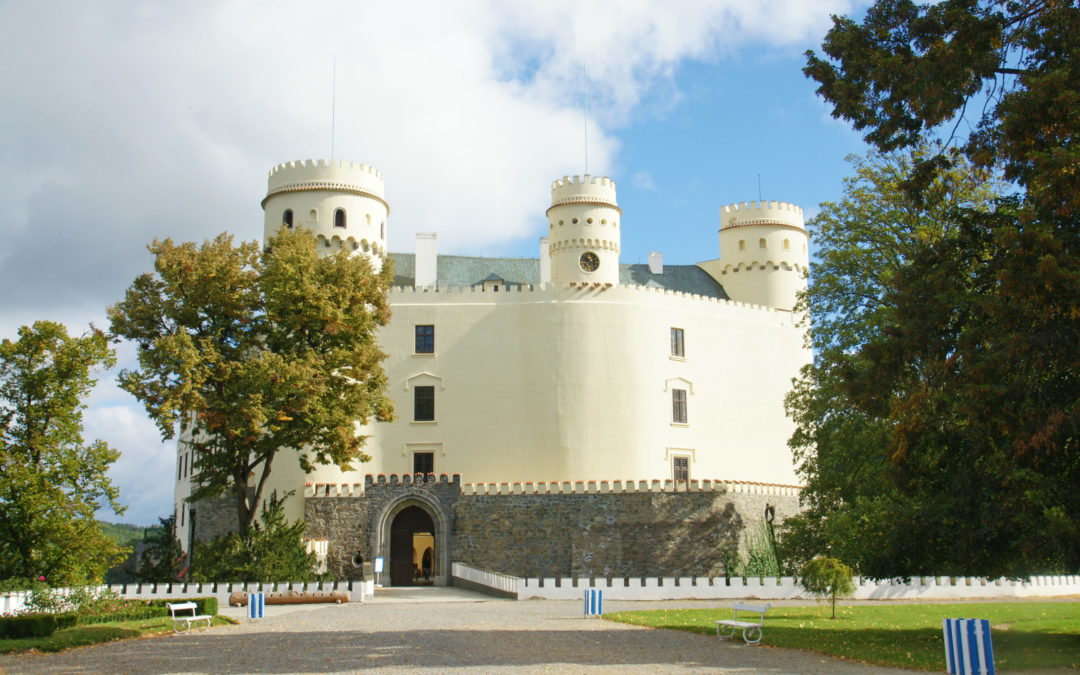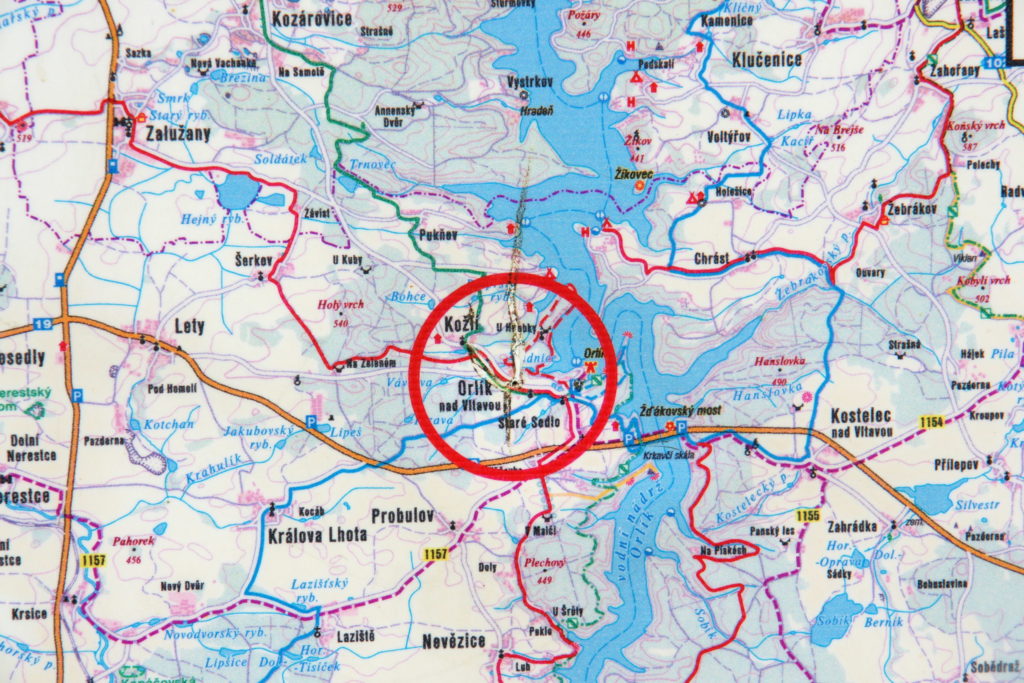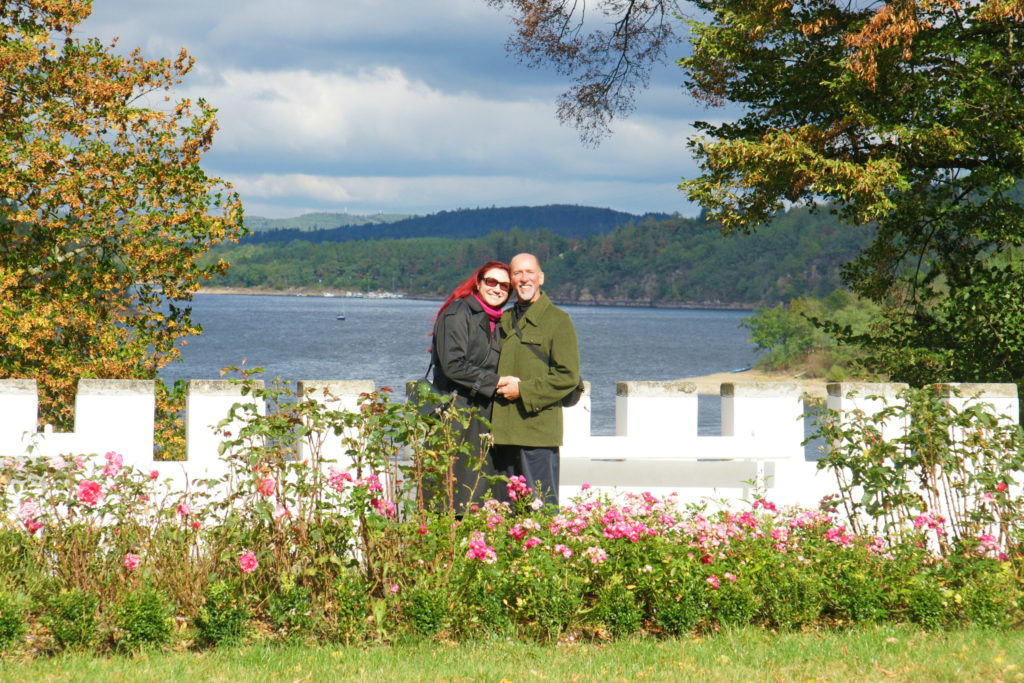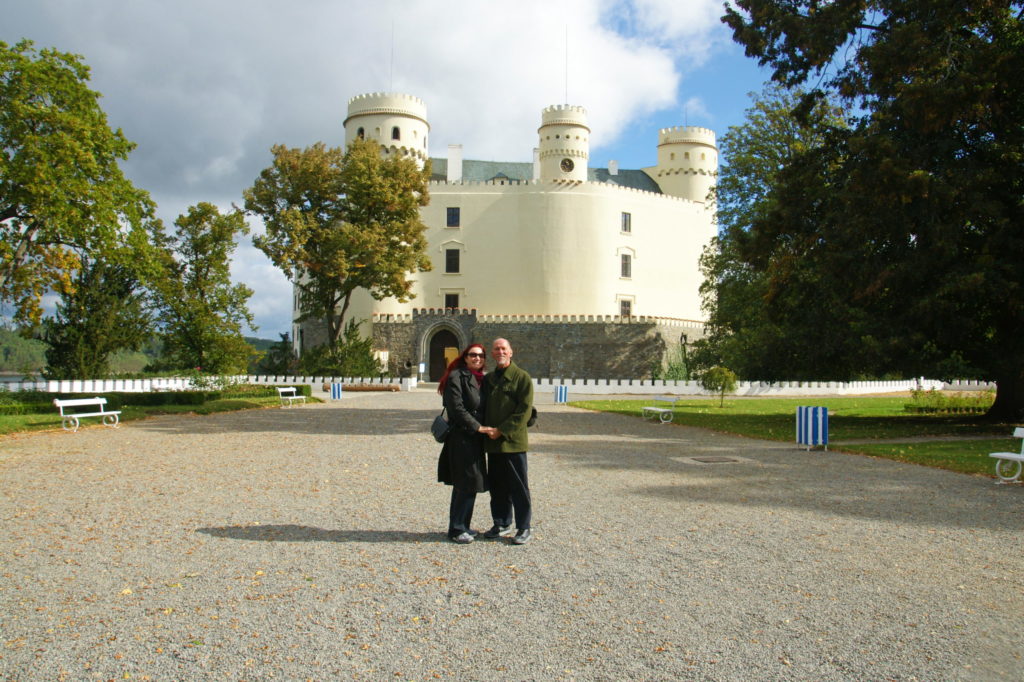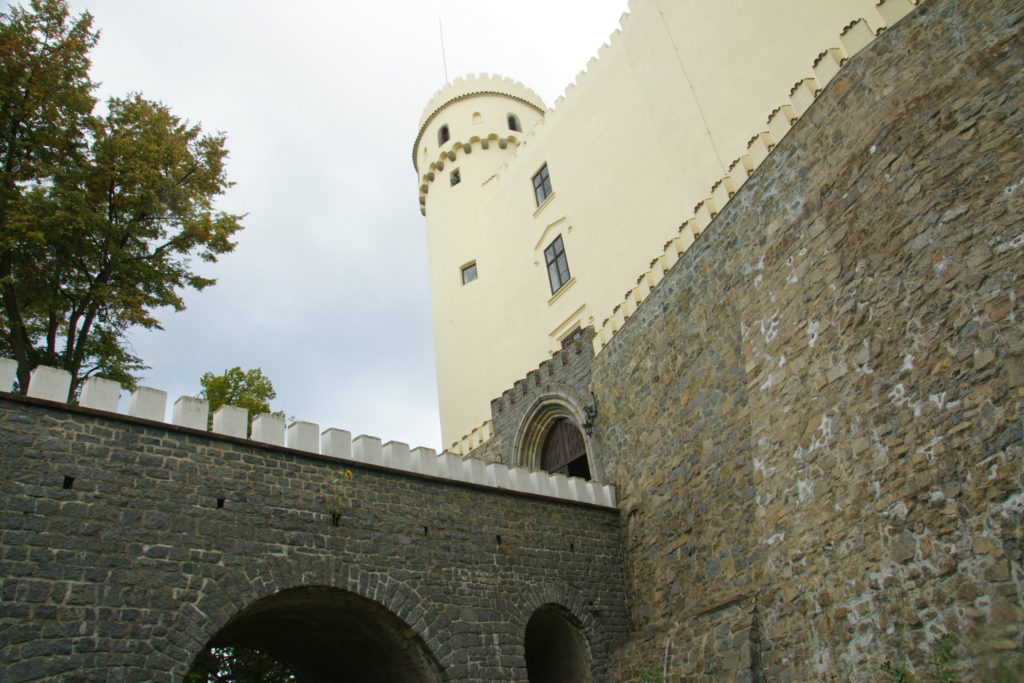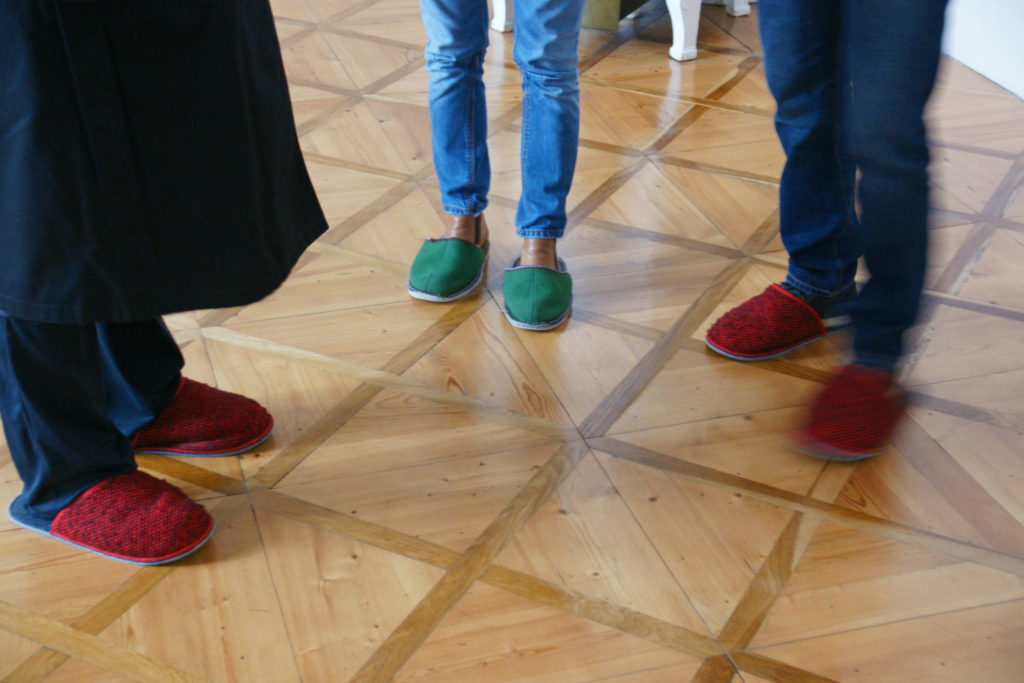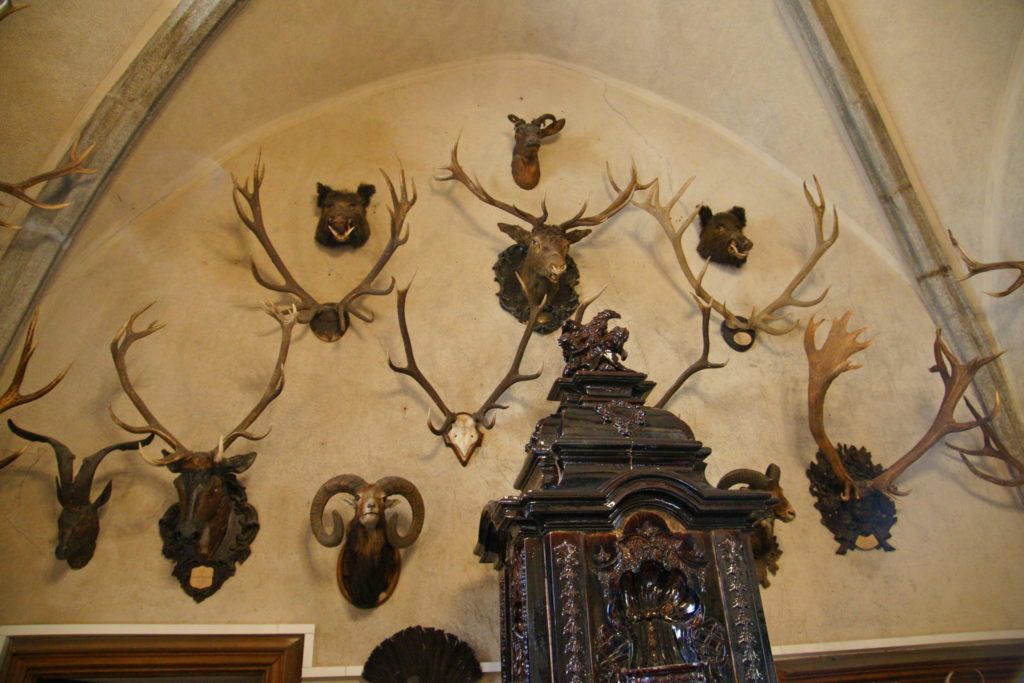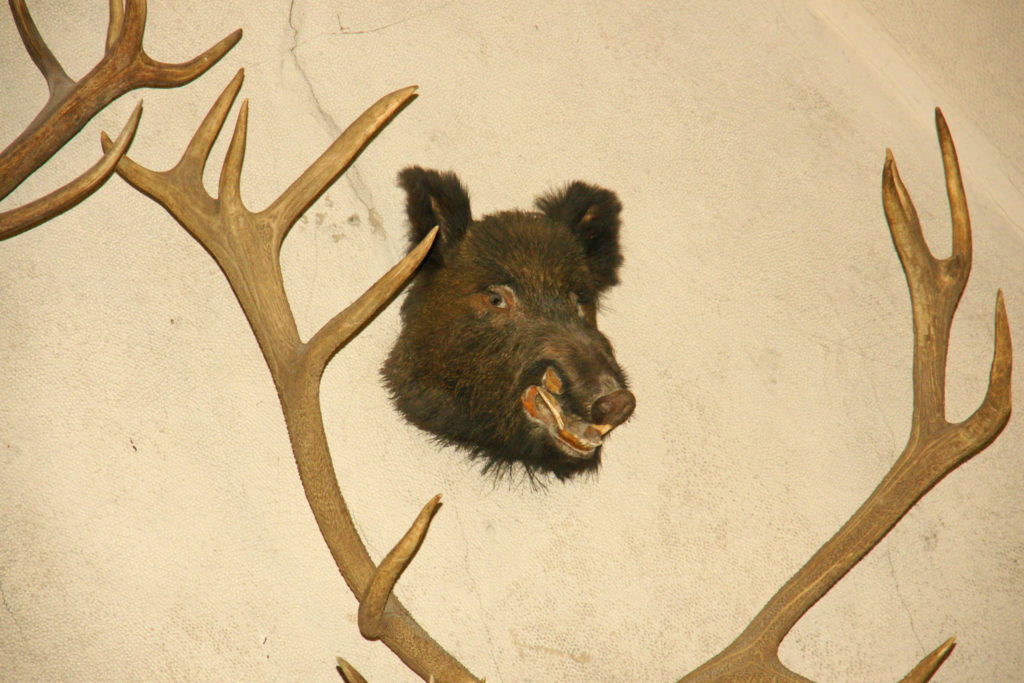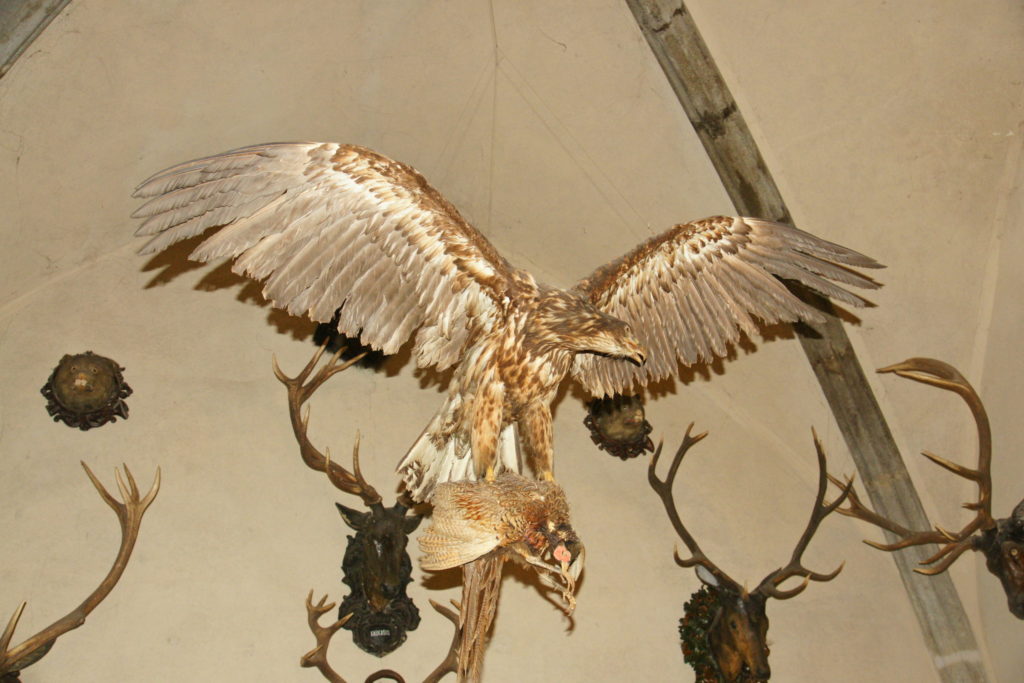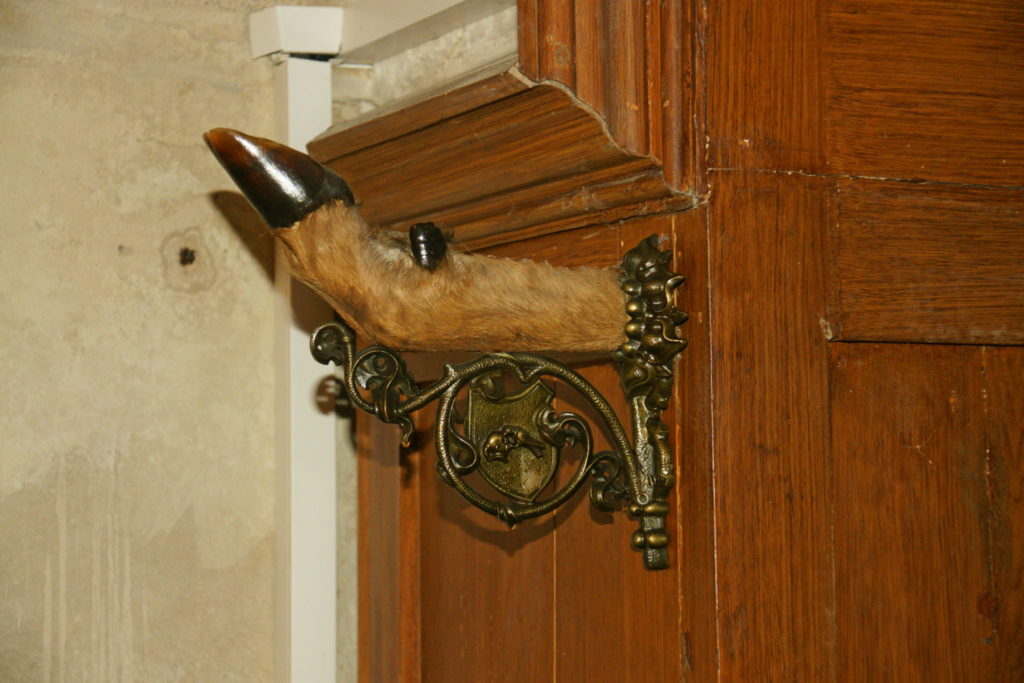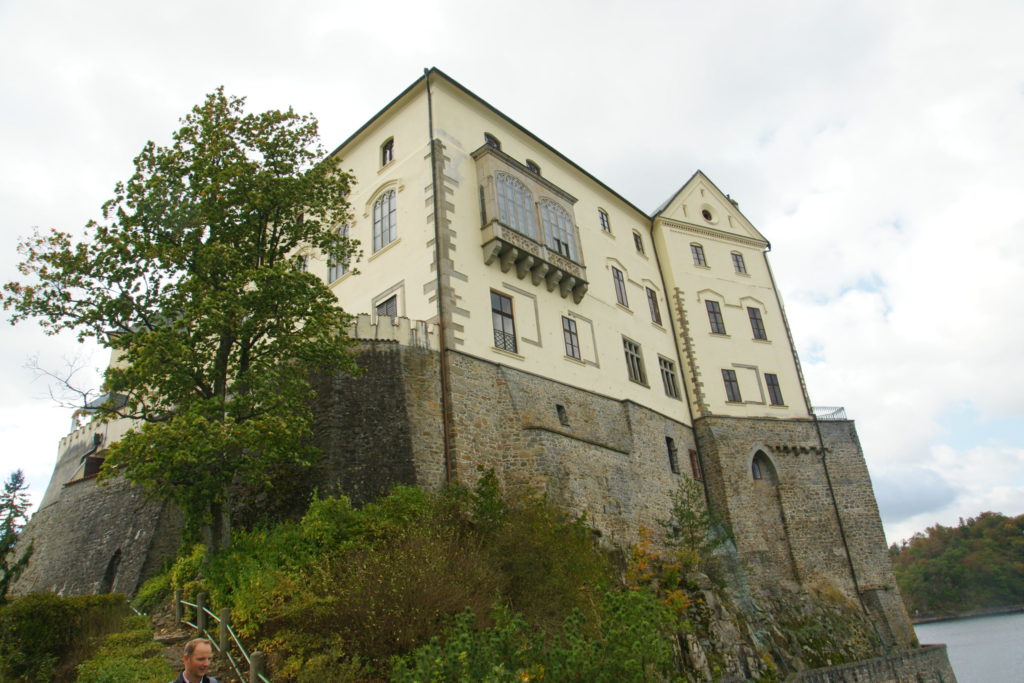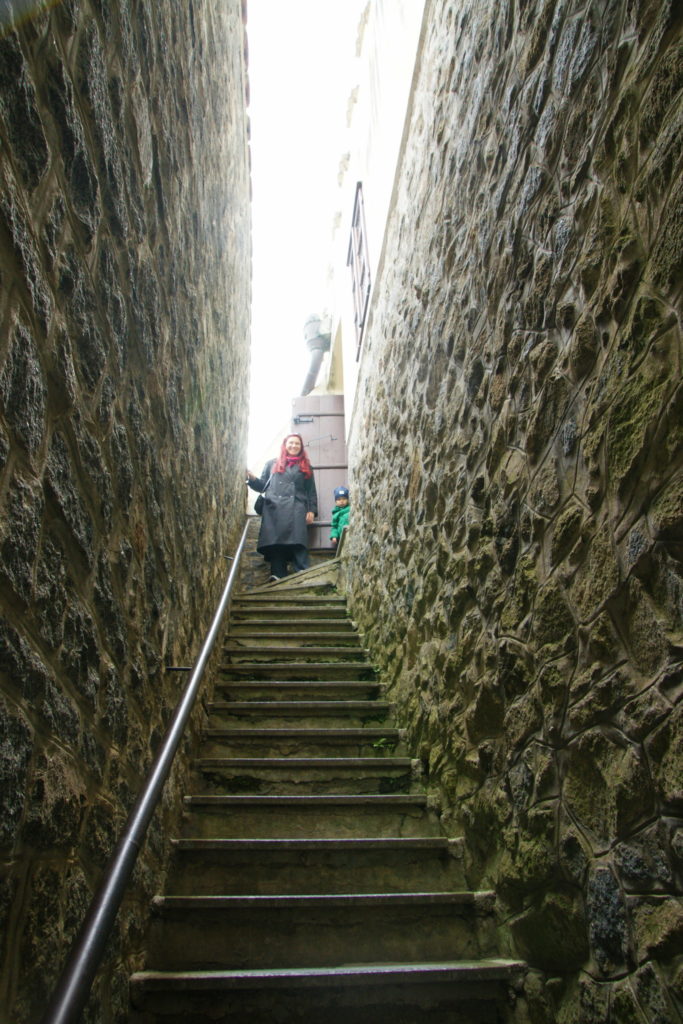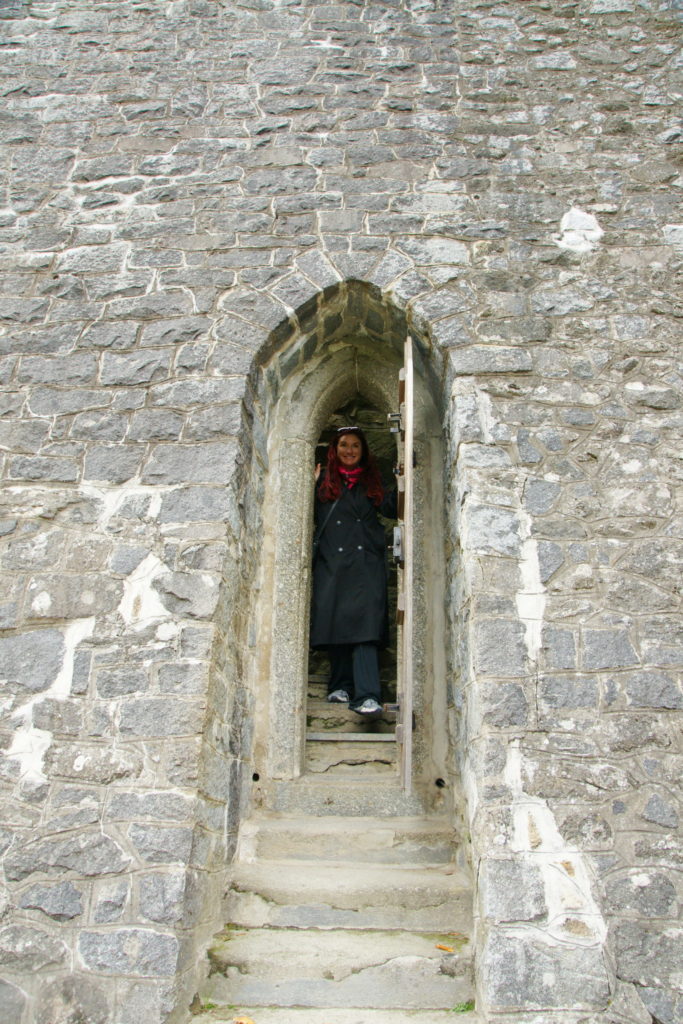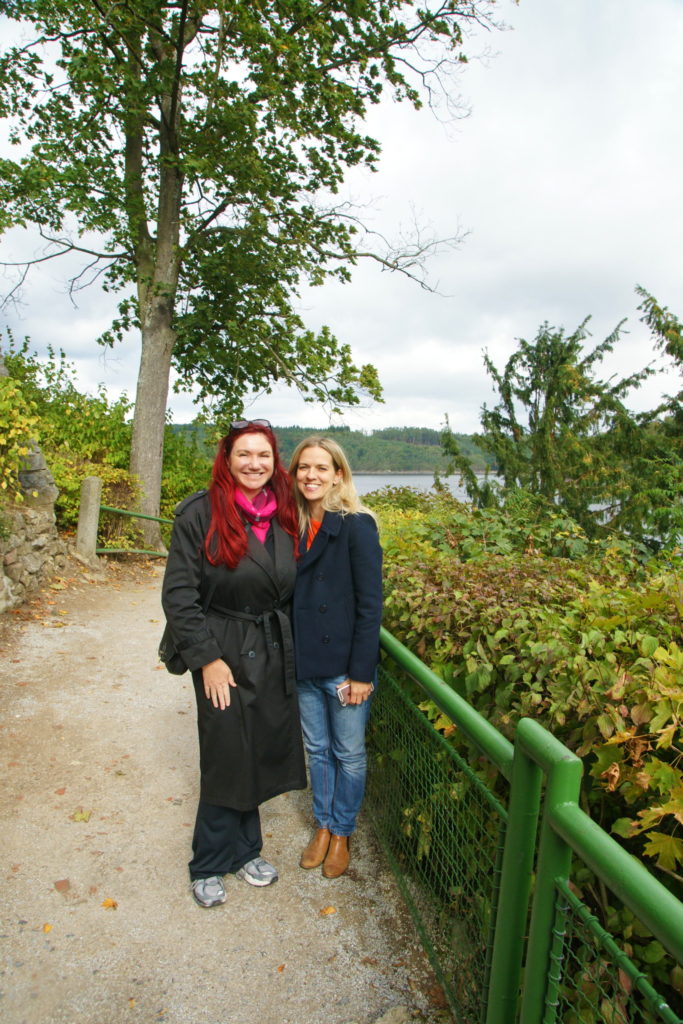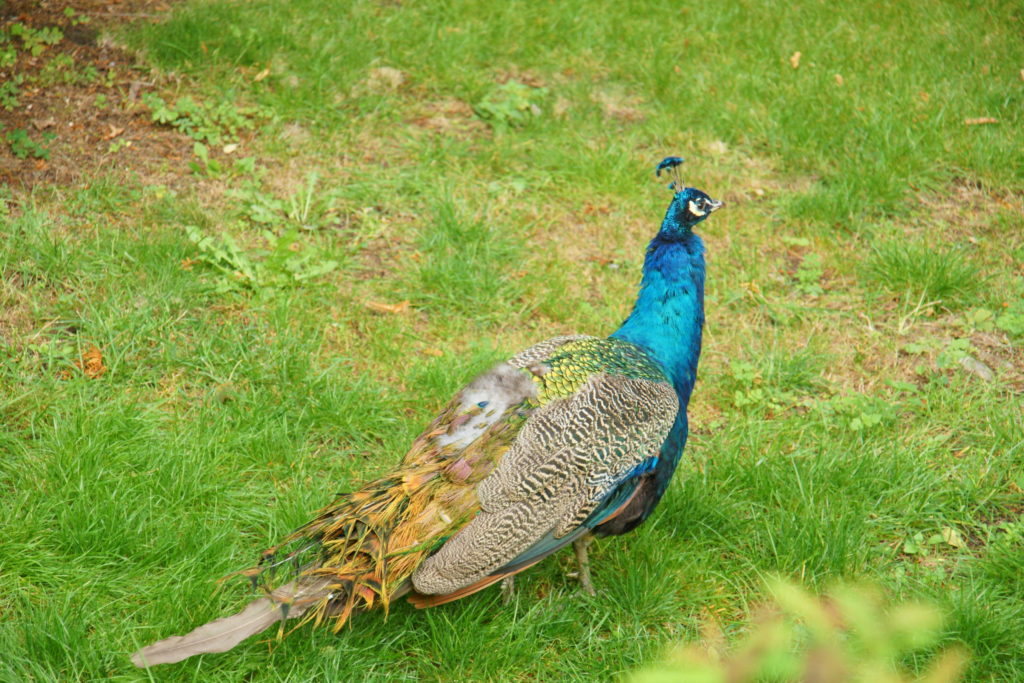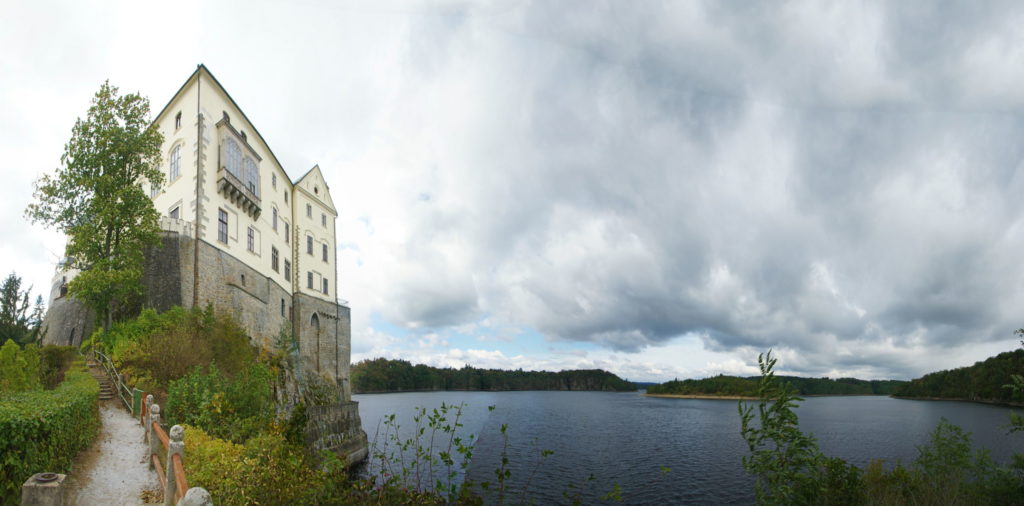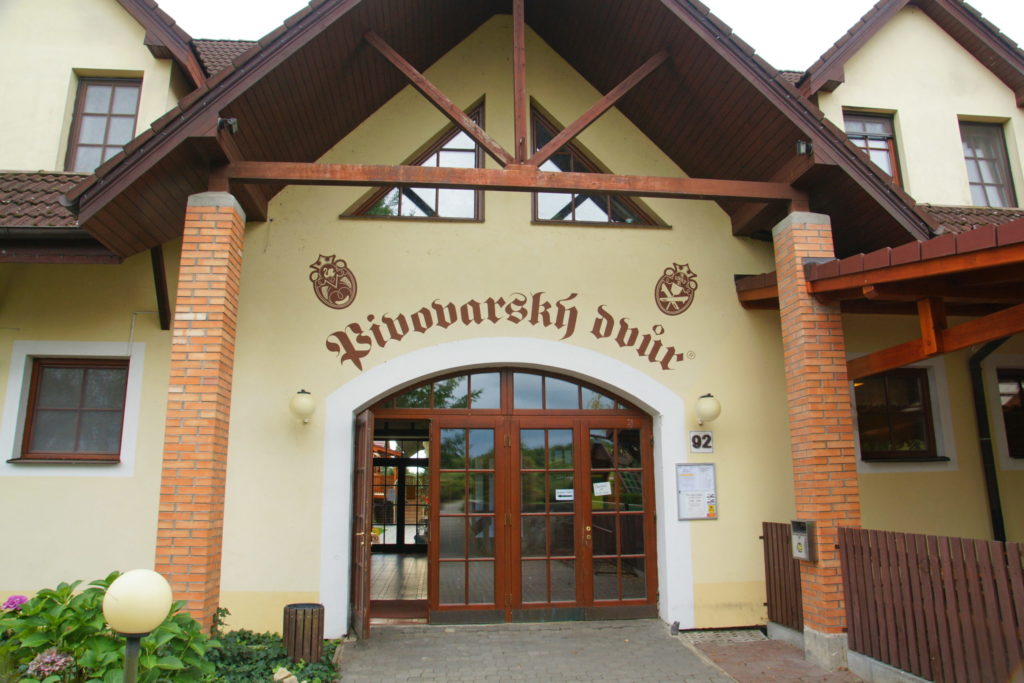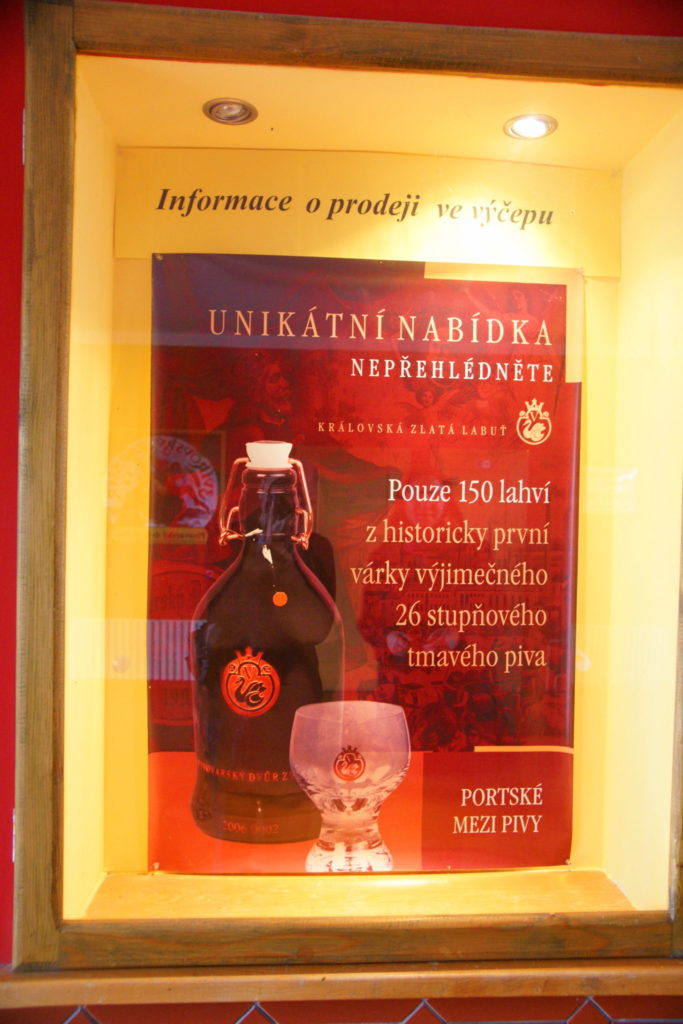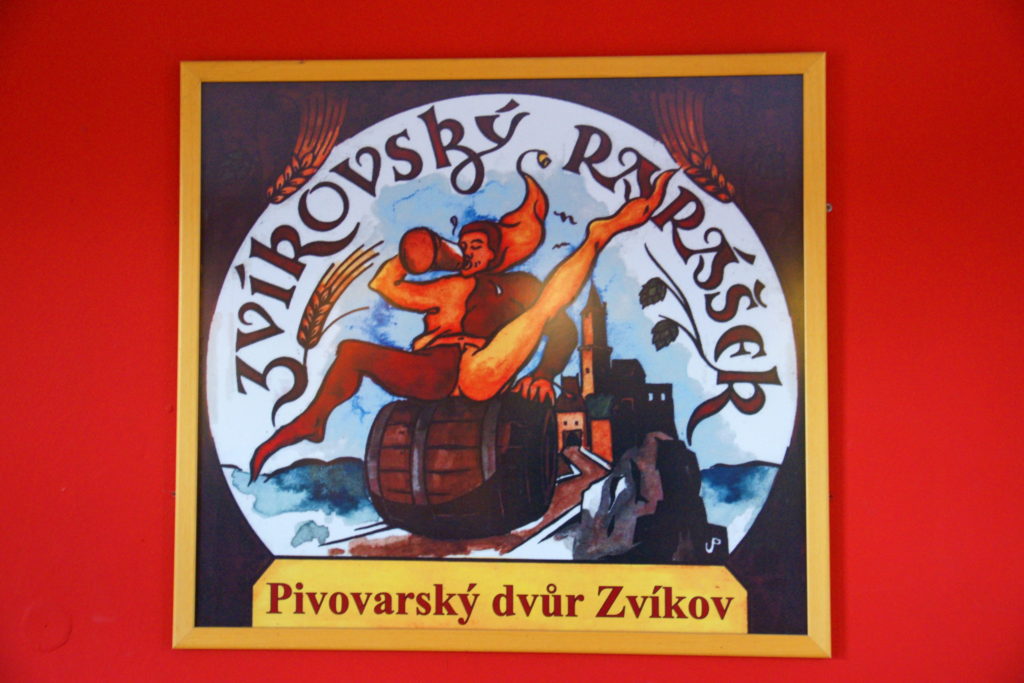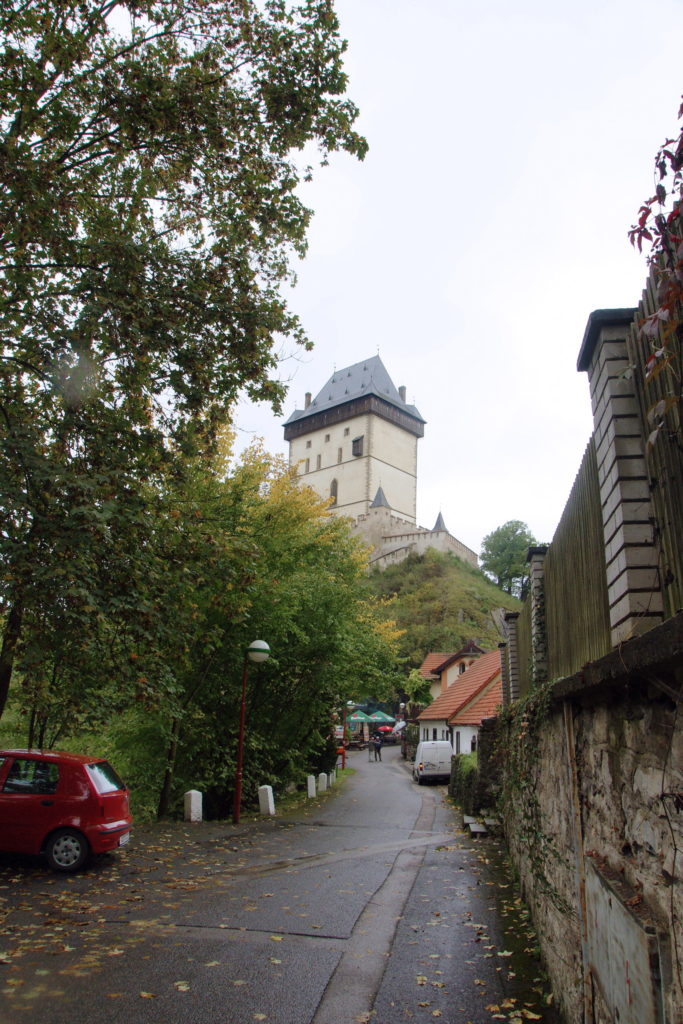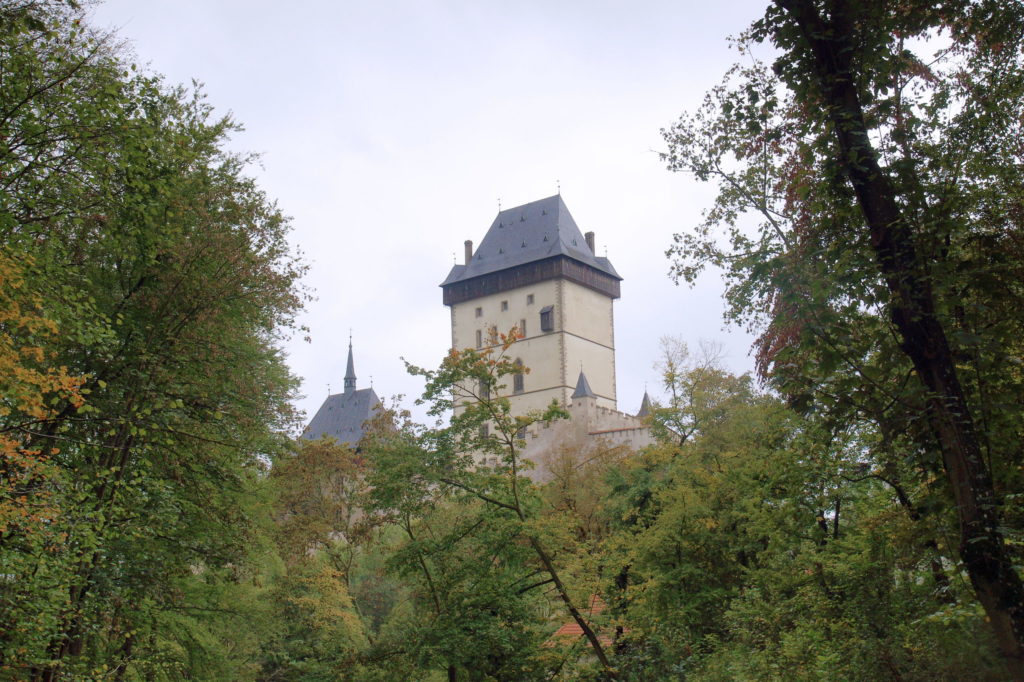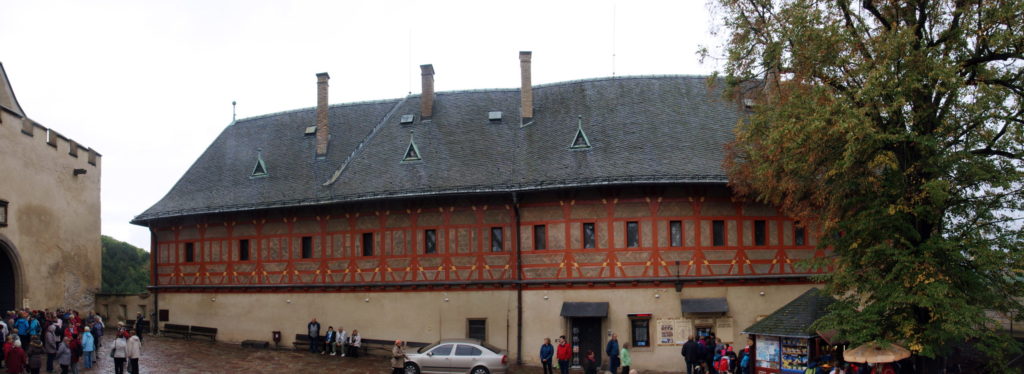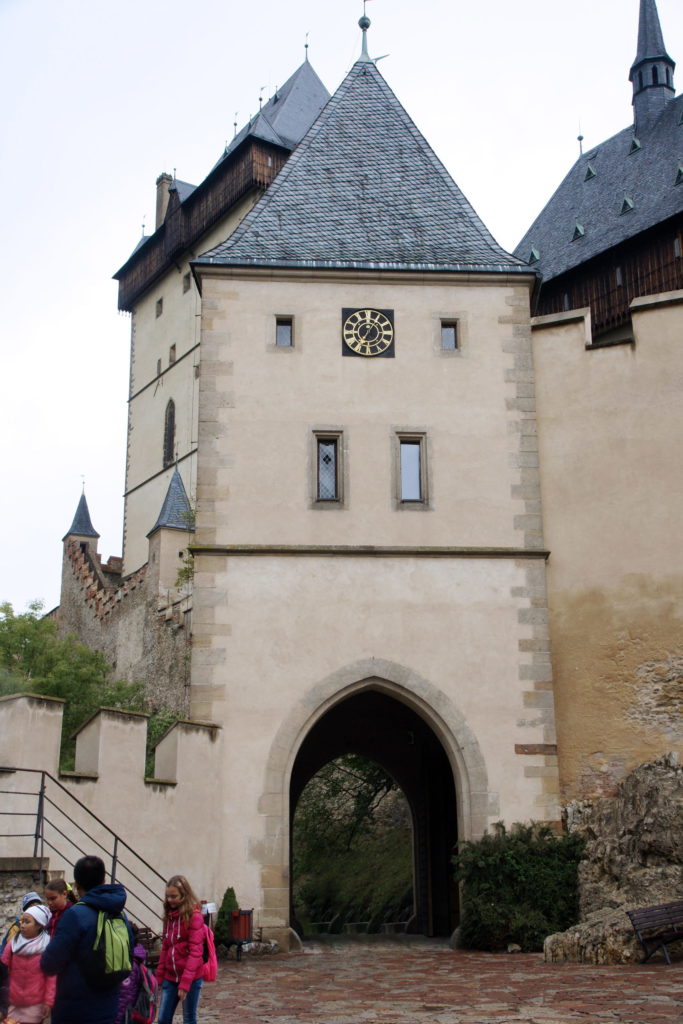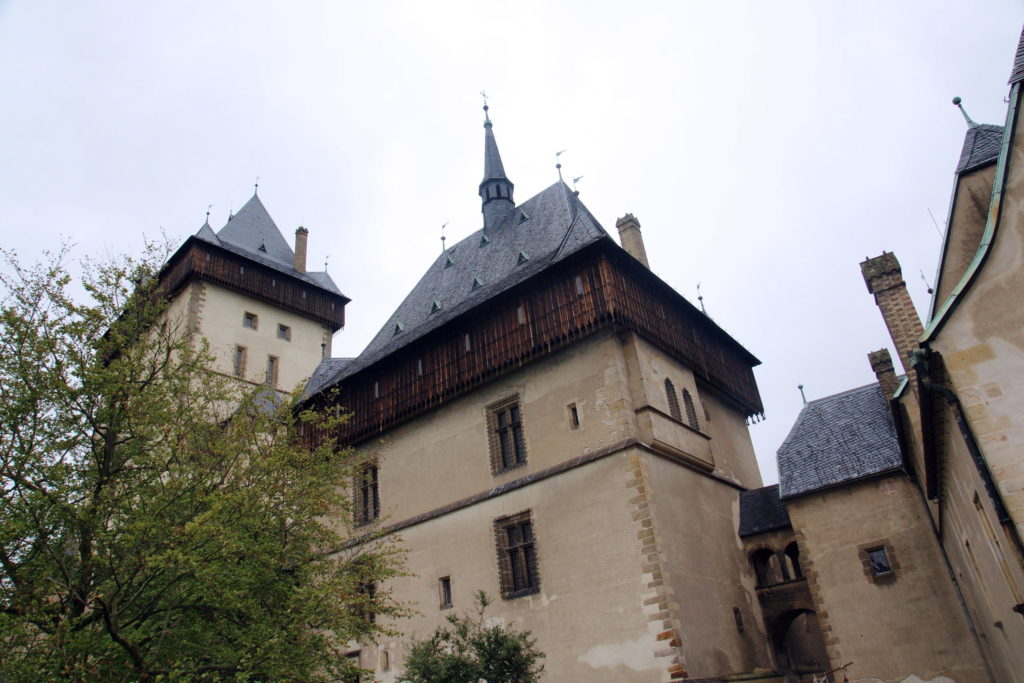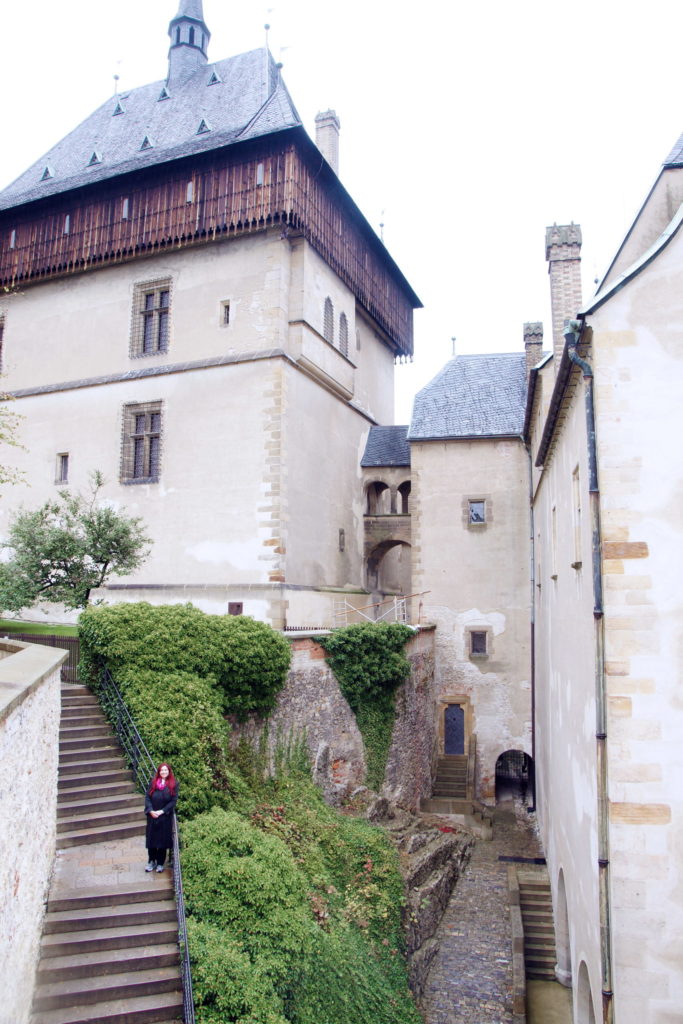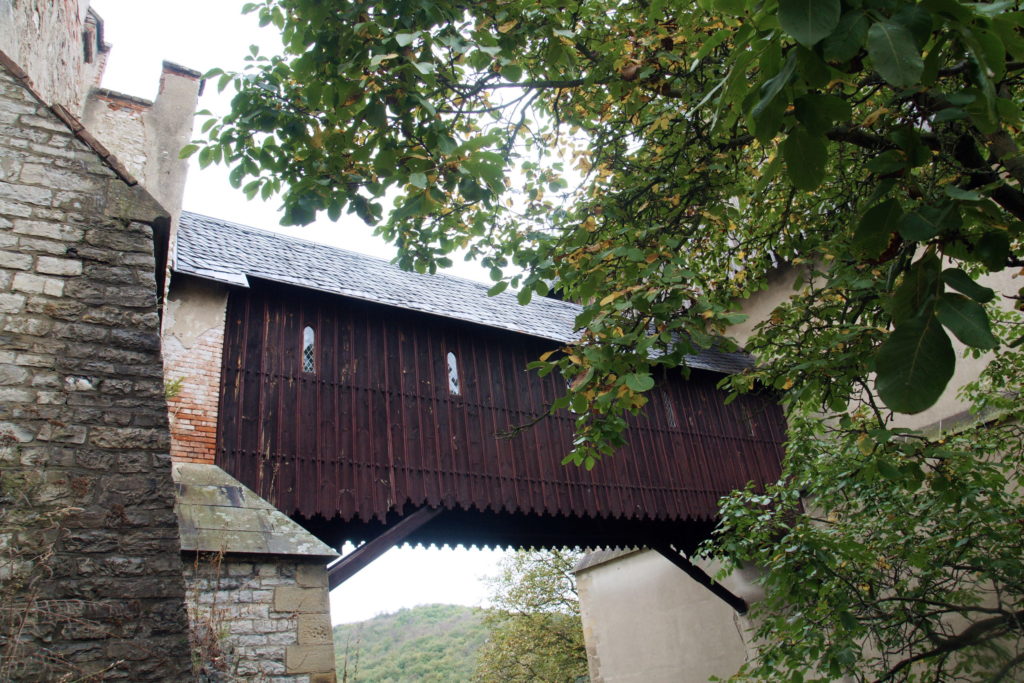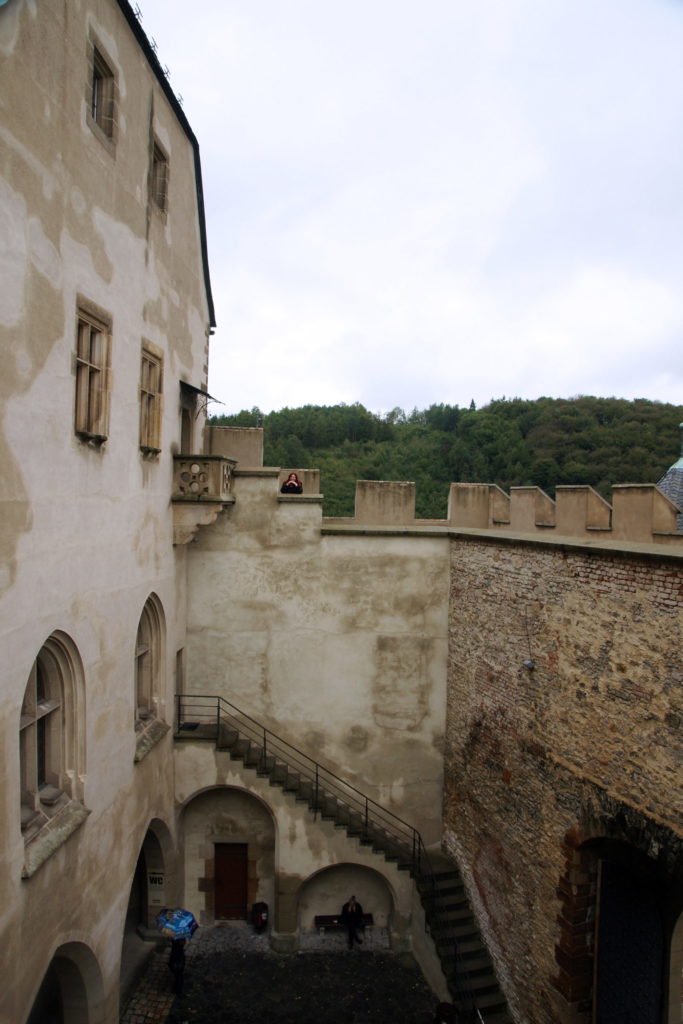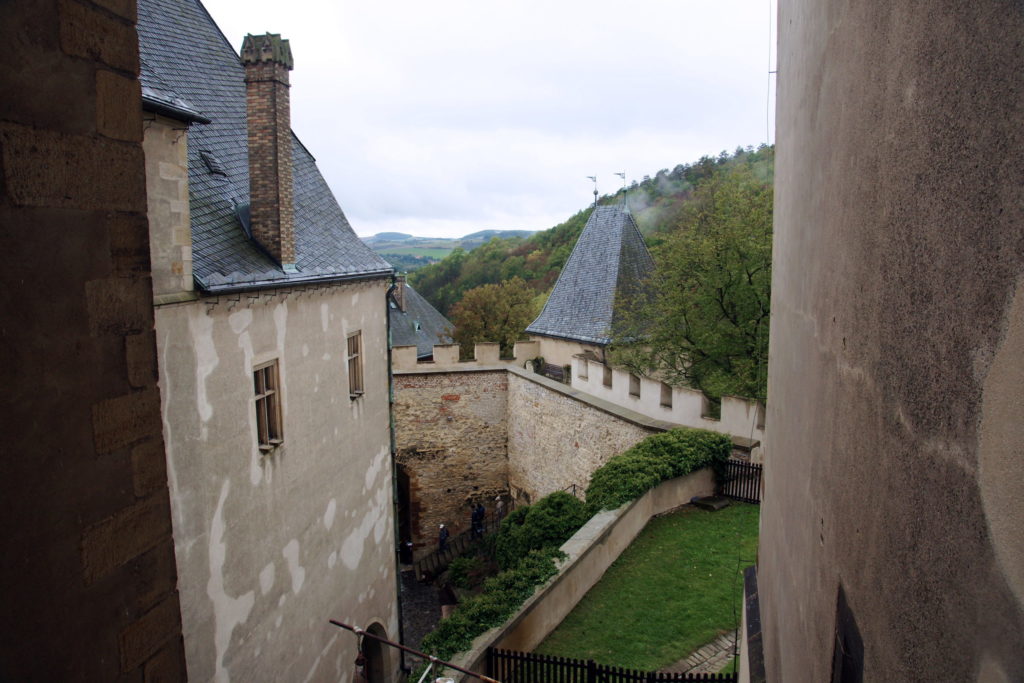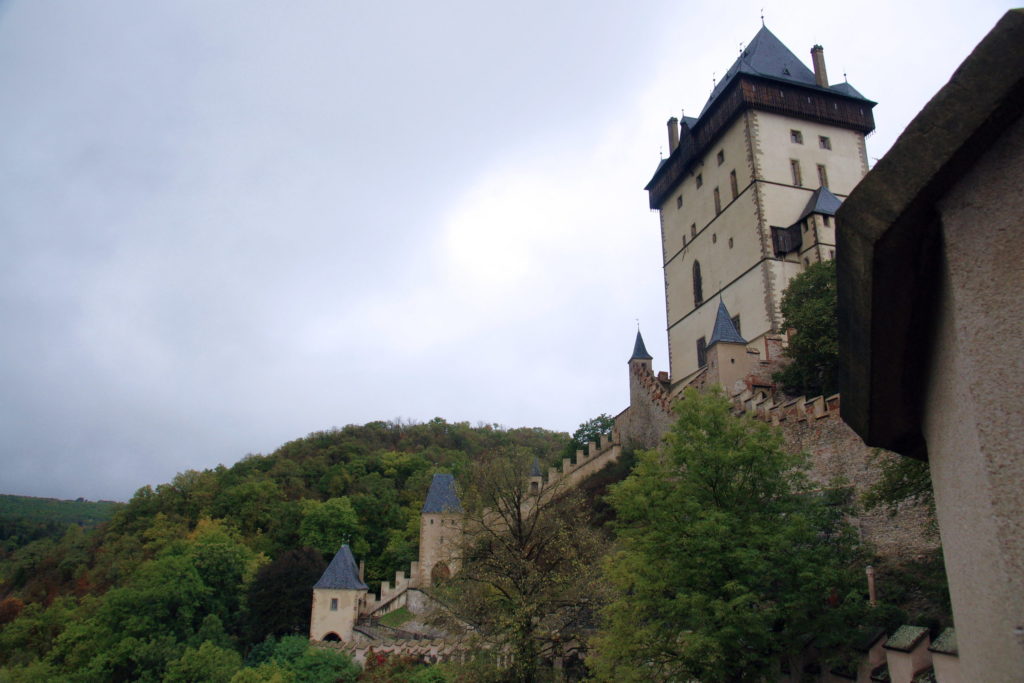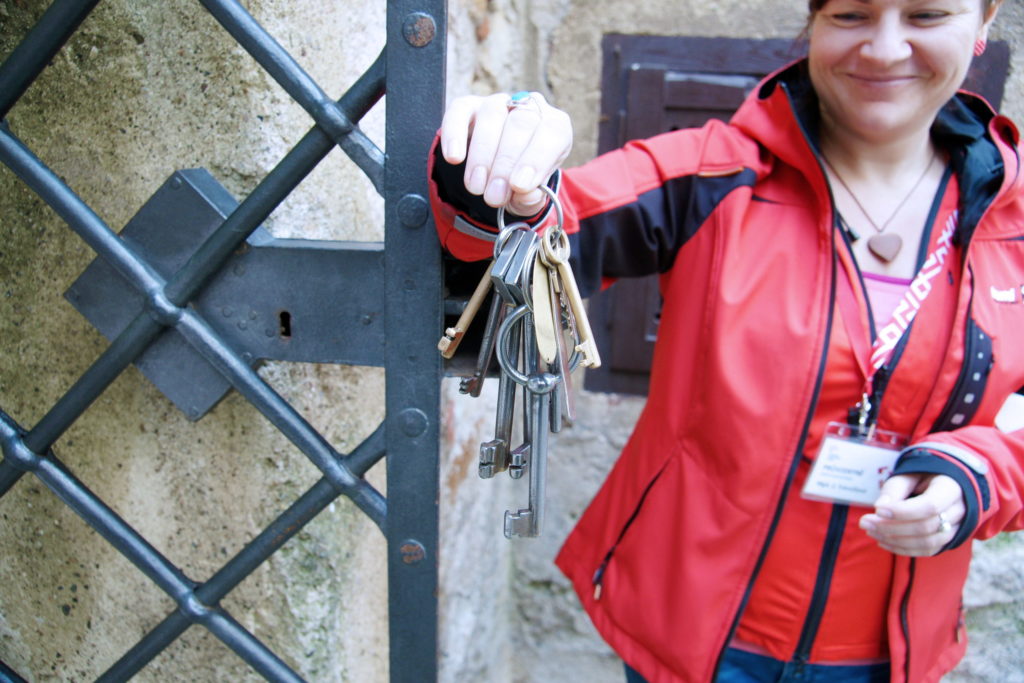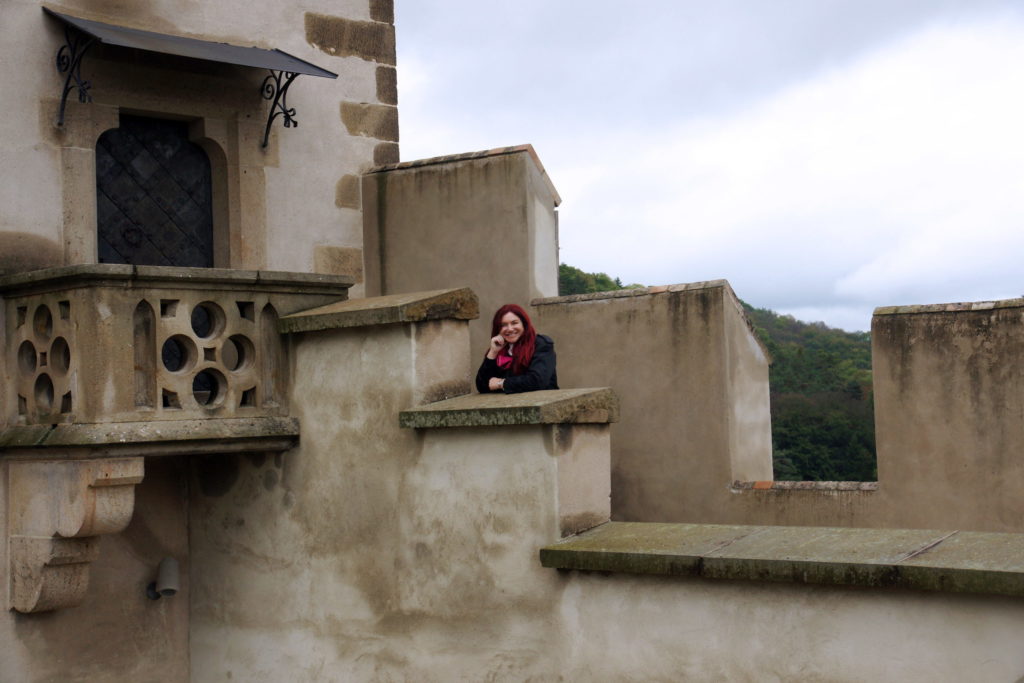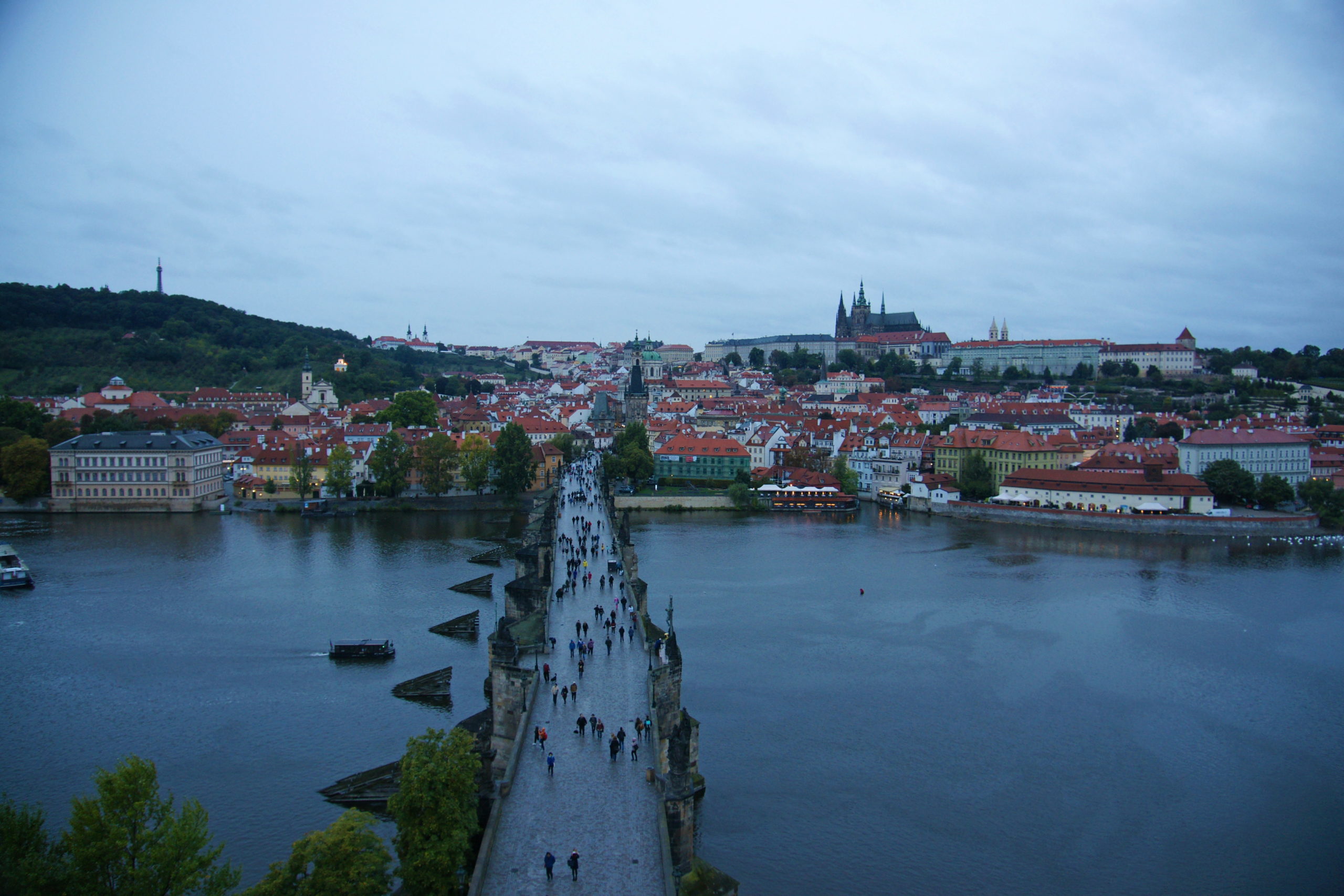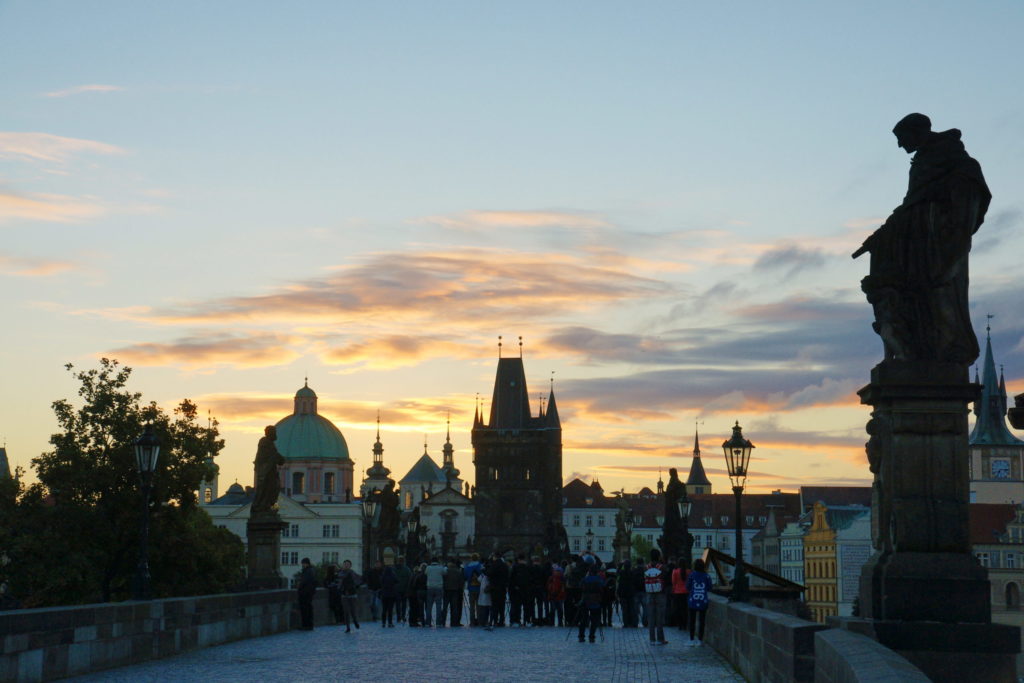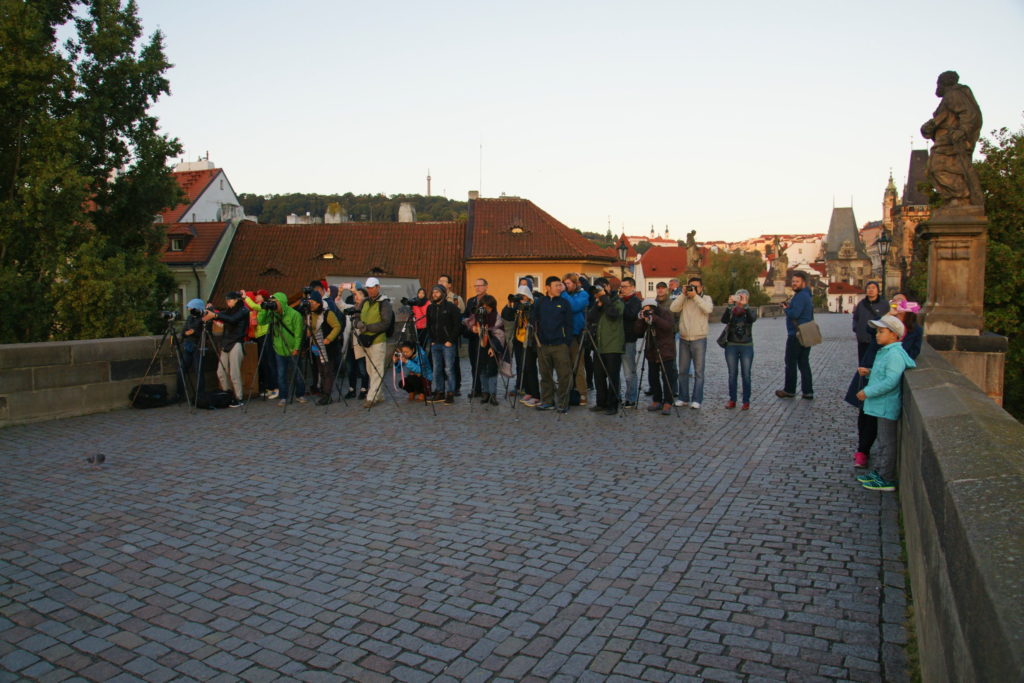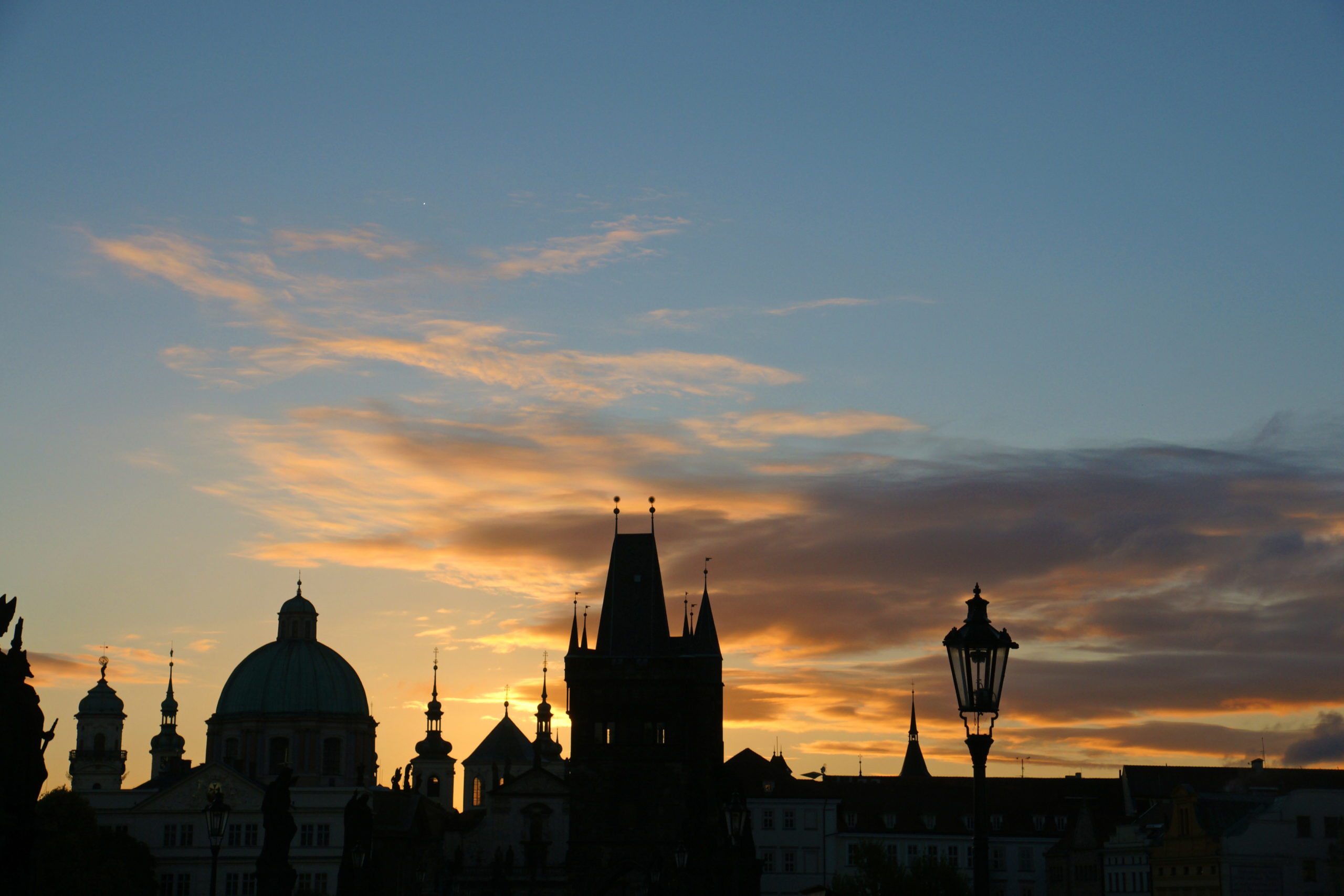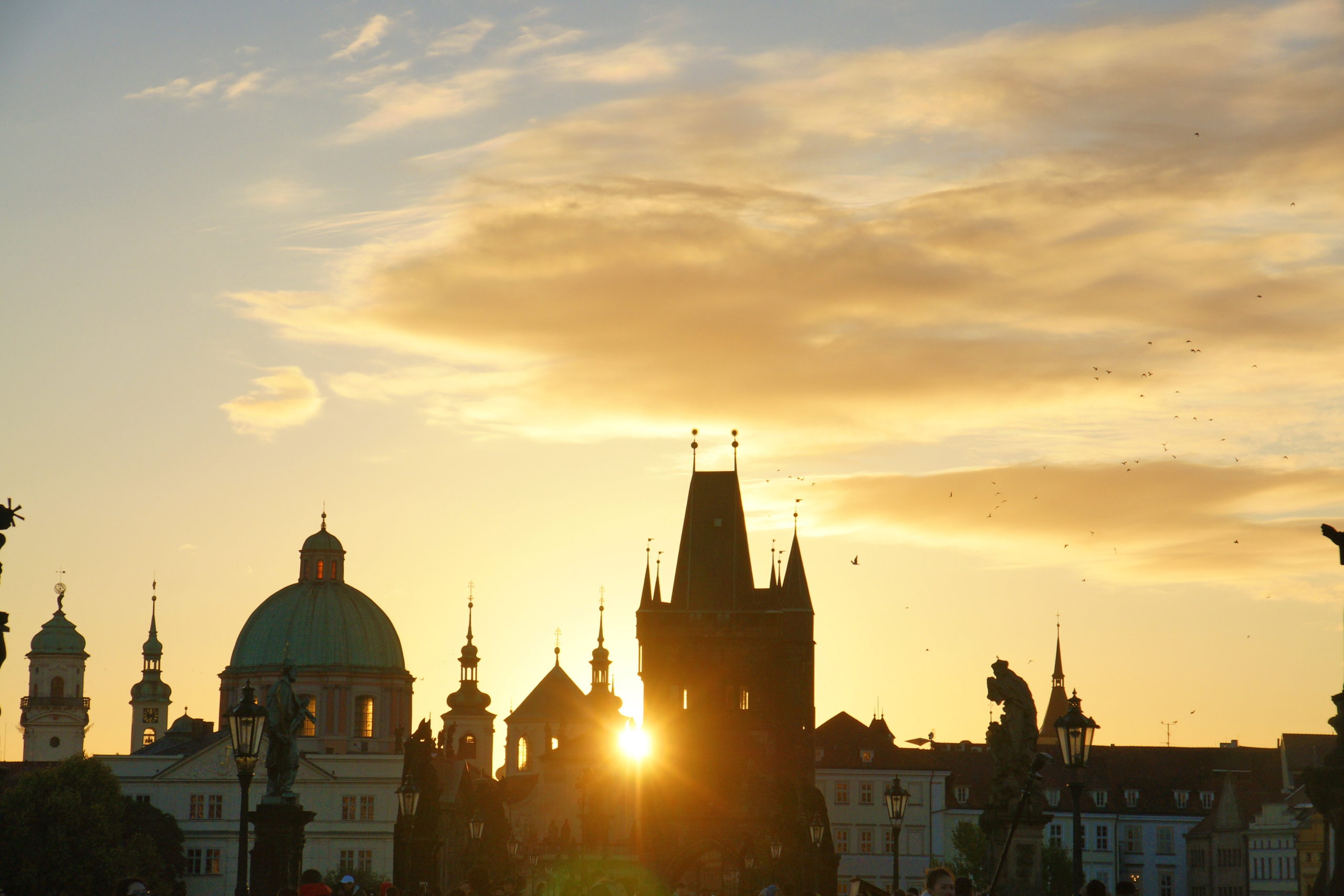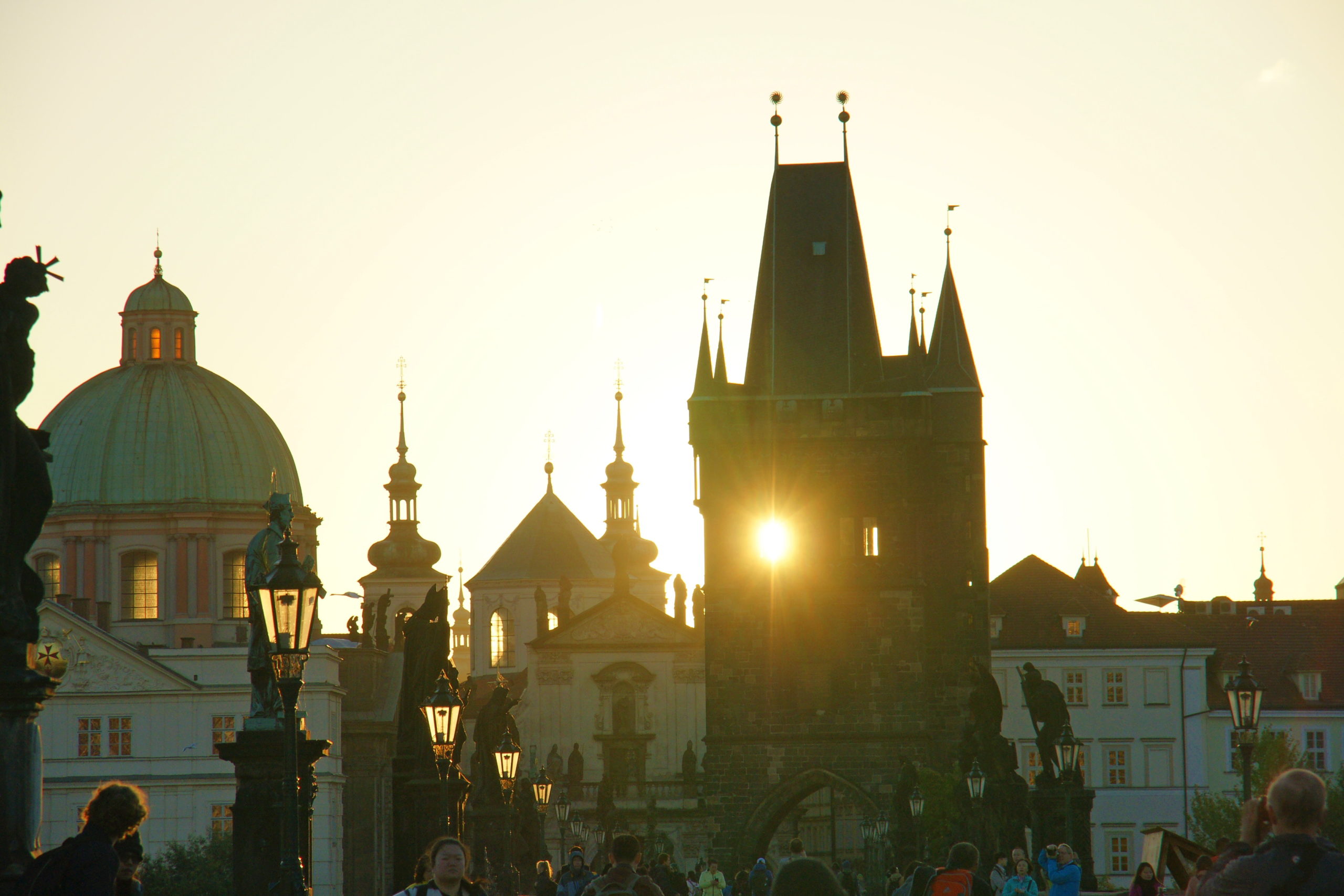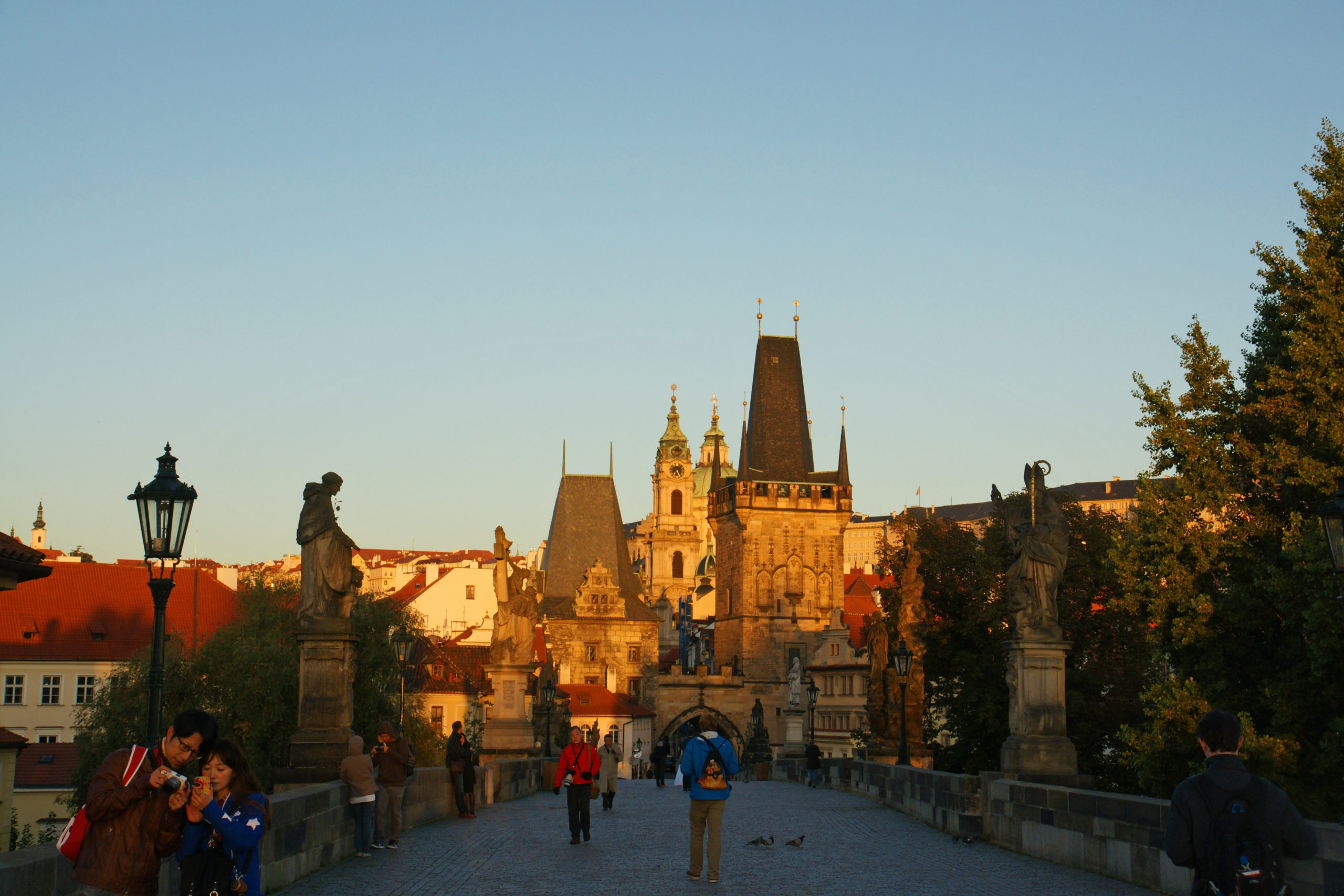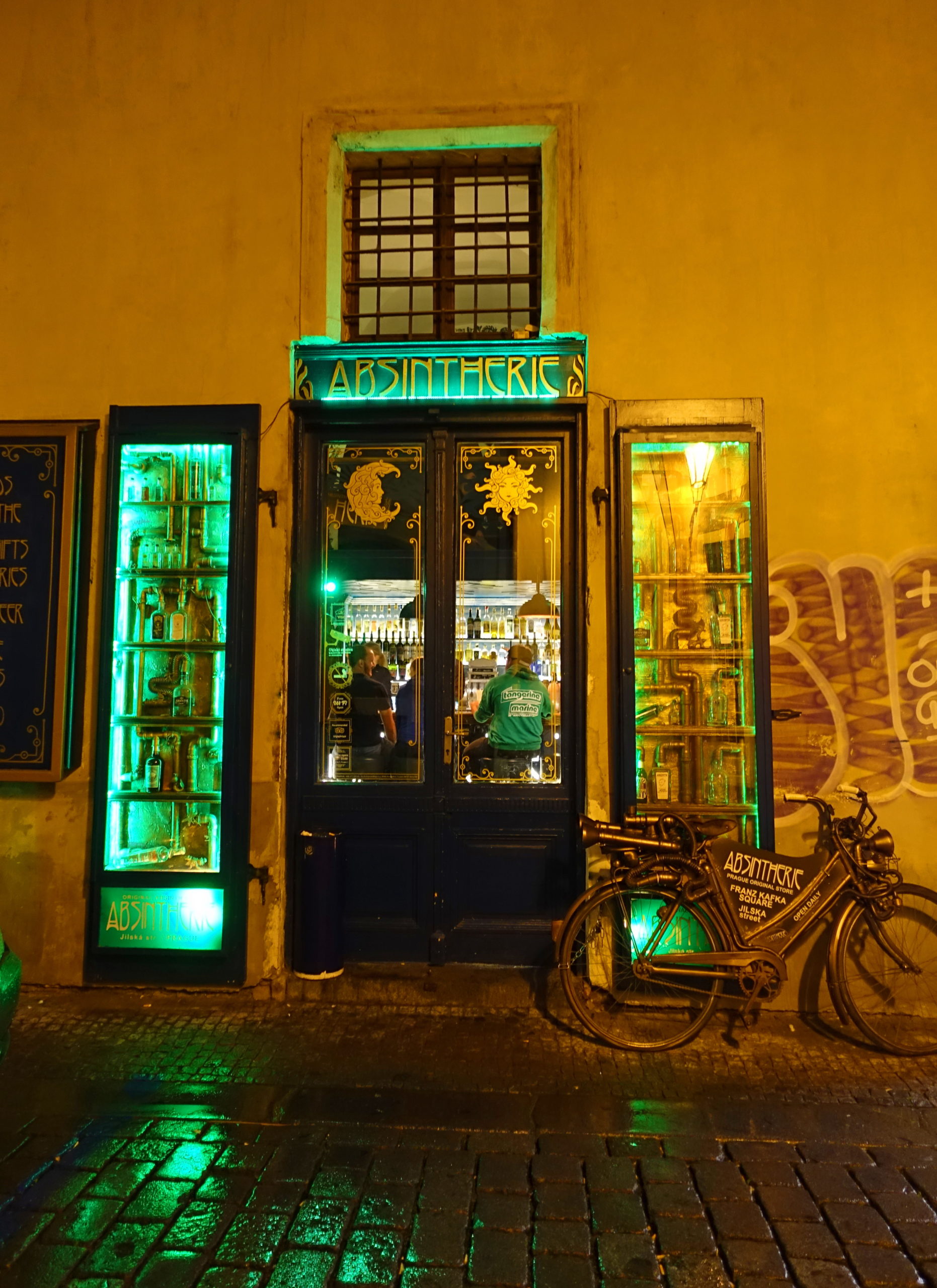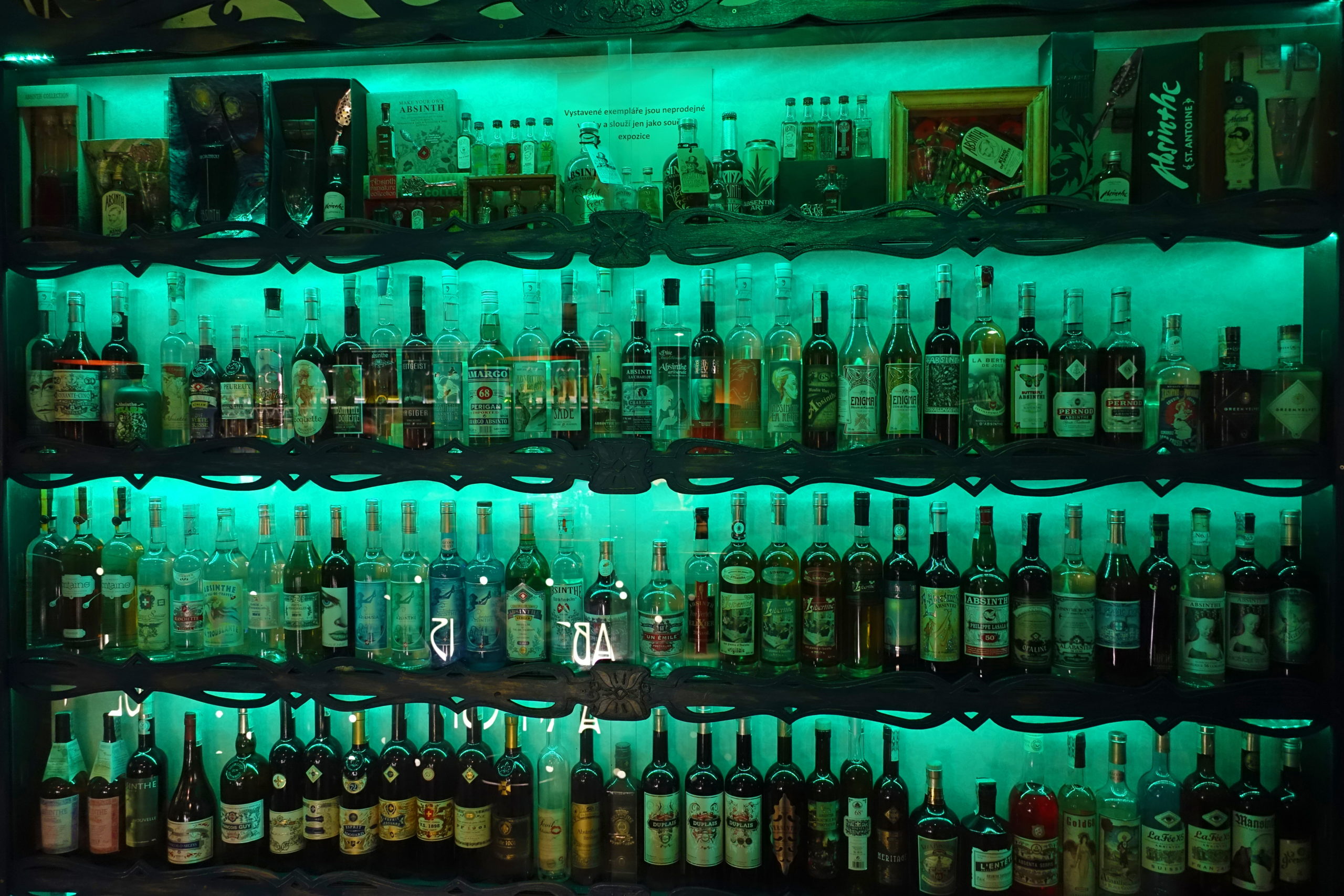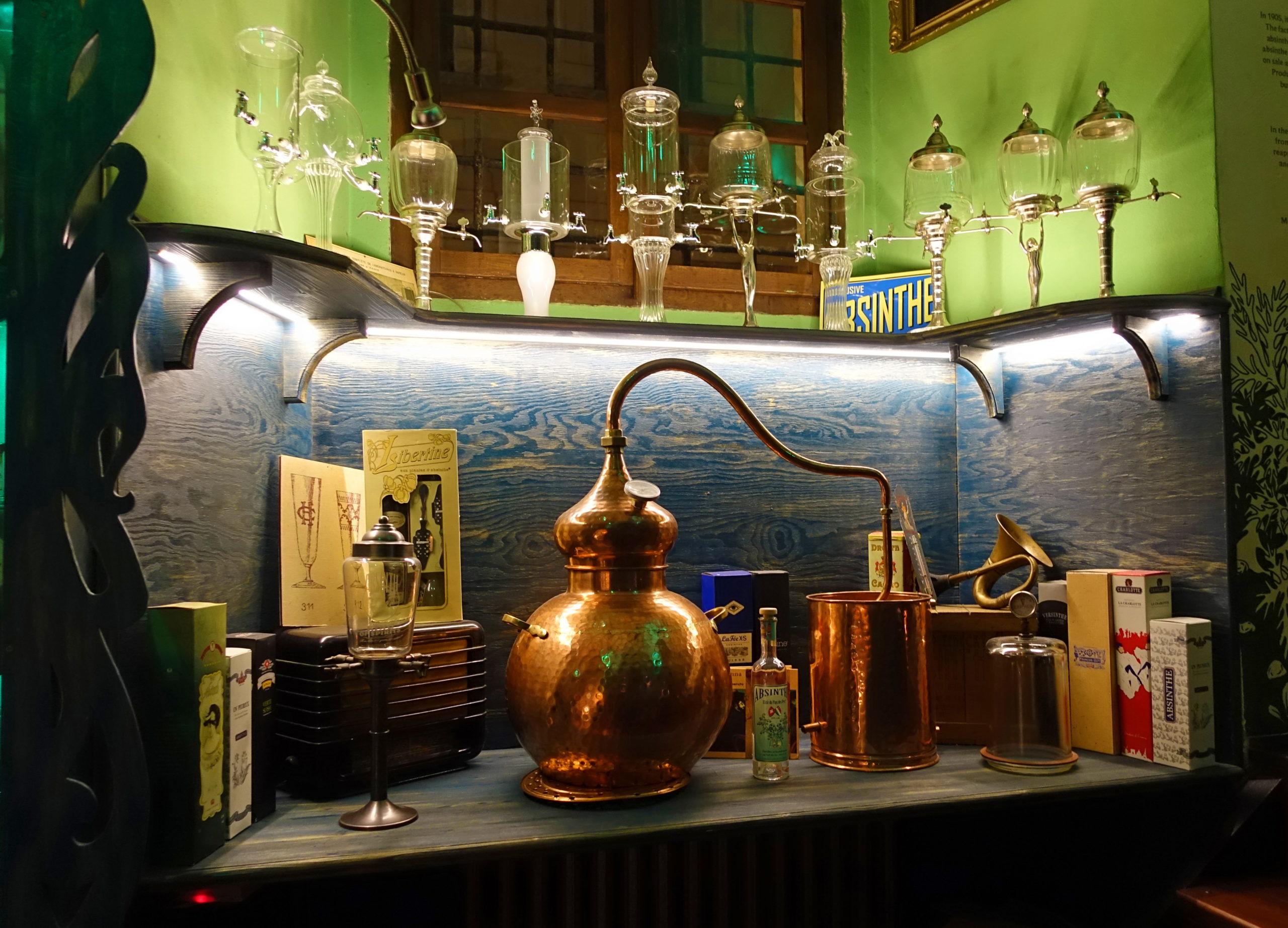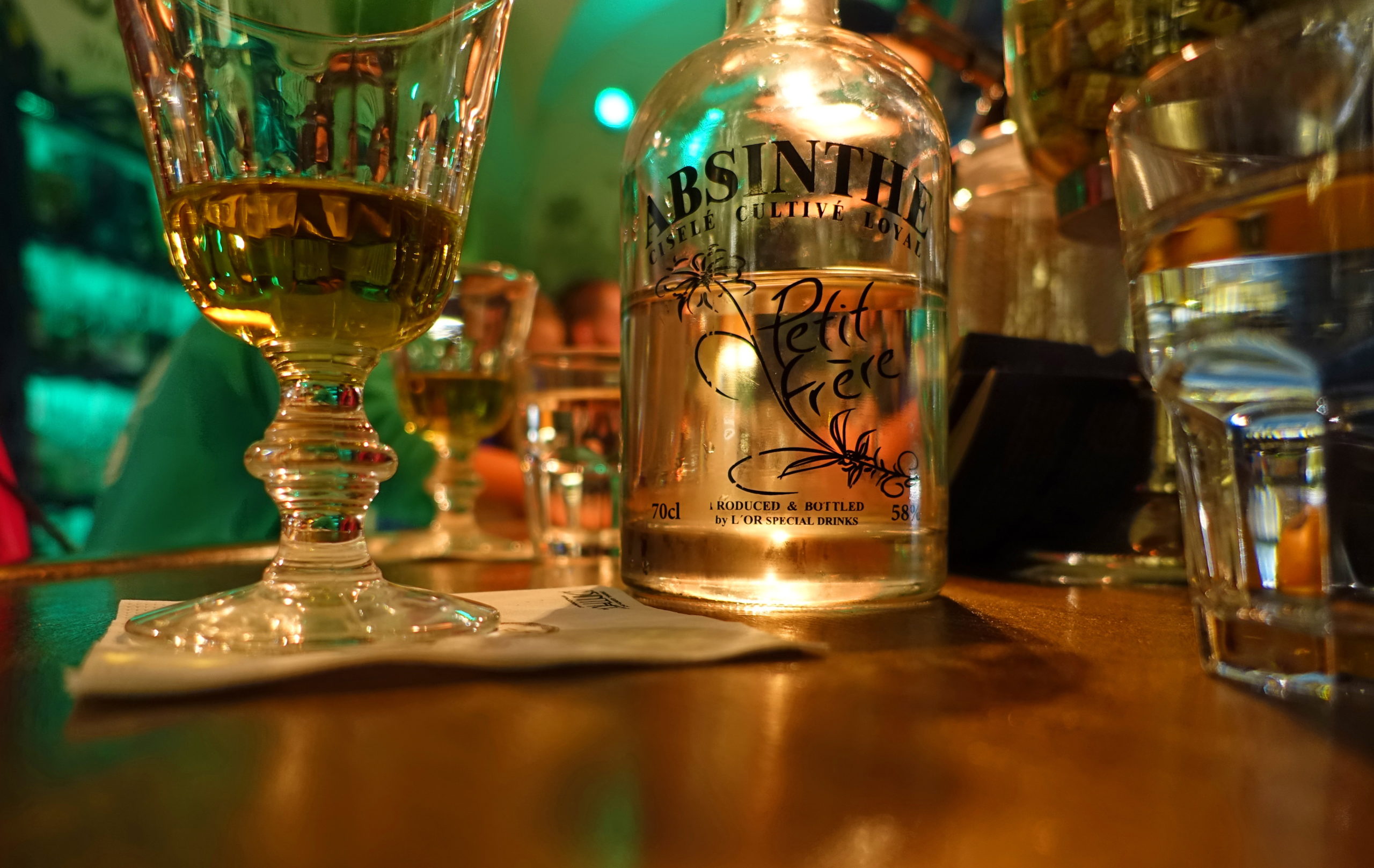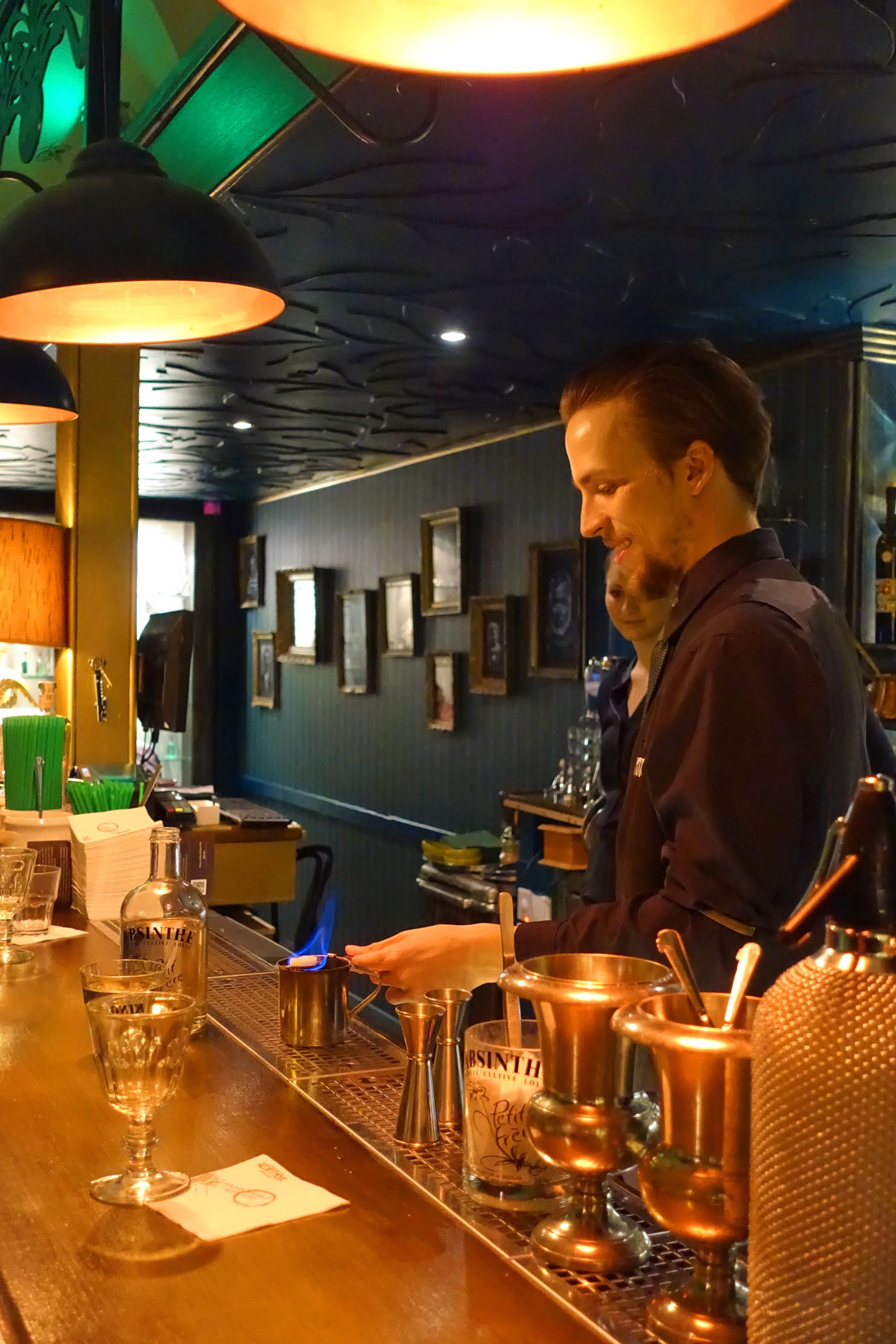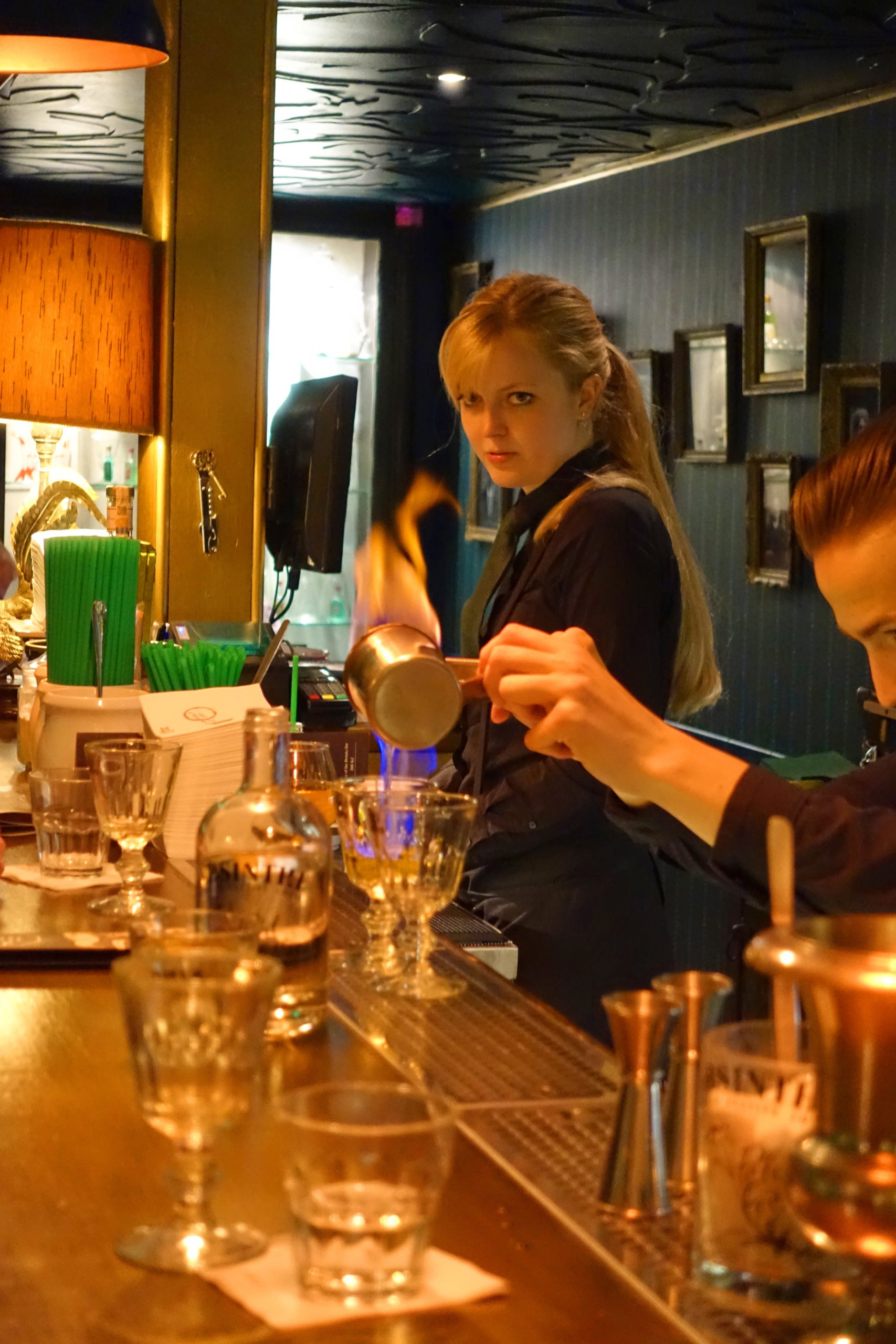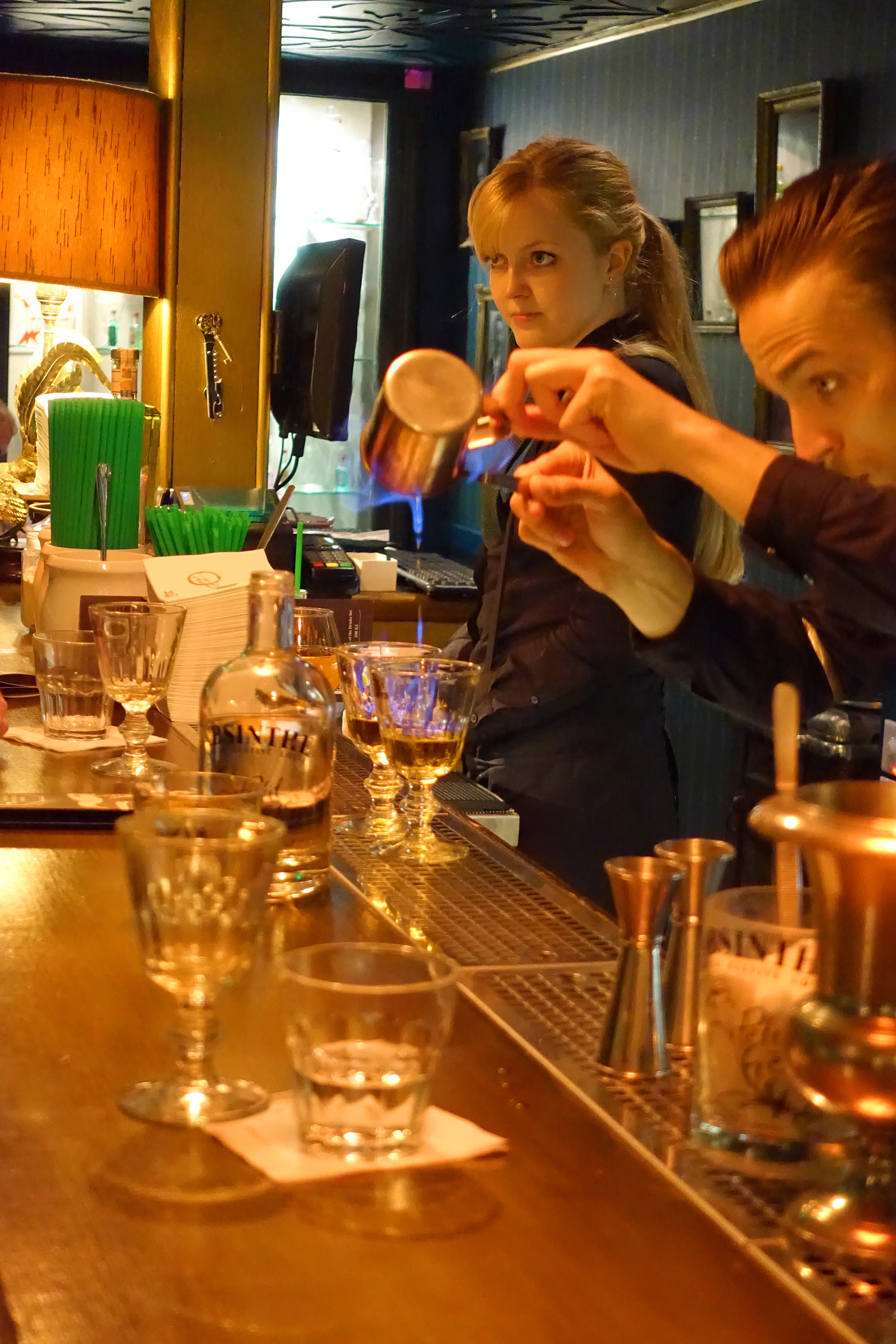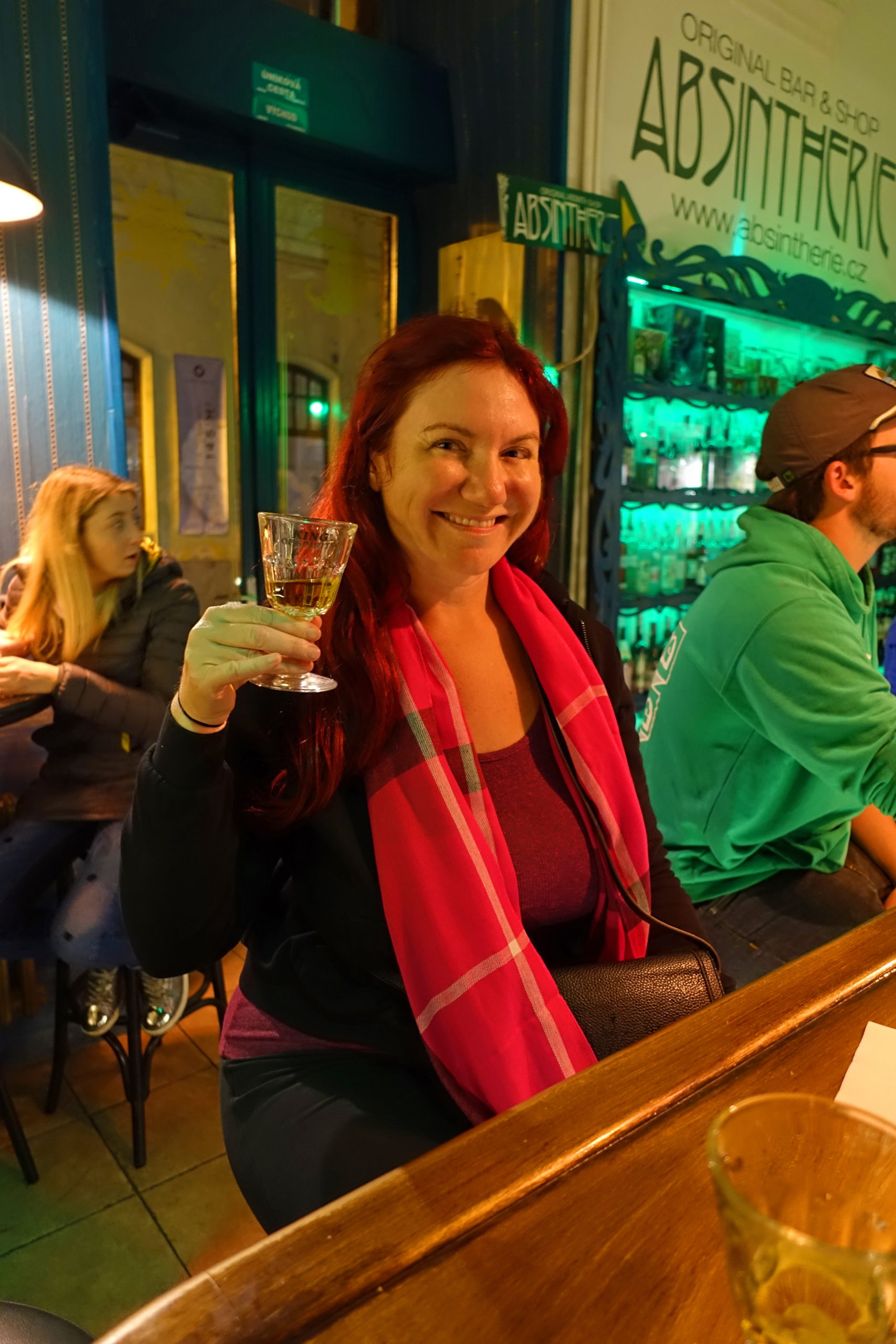Bohemia is the westernmost and largest historical region of the Czech lands in the present-day Czech Republic. It has an area of 52,065 sq. km and today is home to approximately 6.5 million of the Czech Republic‘s 10.5 million inhabitants. Bohemia has a rich cultural history and we are here to learn and explore that history!
Zámek Orlík
Zámek Orlík (Château Orlík in English, but it’s called Orlík Castle) is a château 500 meters northeast of the village of Orlík nad Vltavou in the South Bohemia Region of the Czech Republic.
The original position of the chateâu, on a rock 60 meters above the Vltava valley, was altered by the creation of the Orlík reservoir in 1954–62, and the chateâu is now barely a few meters above the water level. The meaning of the name Orlík stems from the word “young eagle” (Czech: Orel). It is often suggested that this castle would have resembled an eagle or nest perched upon the rocky outcrop above a turn in the river.
The Orlík Reservoir (behind us) is the largest hydroelectric dam in the Czech Republic. It dams the Vltava River near the village of Solenice, which is near the town of Příbram—but you knew that, right? The dam has four turbines with a nominal capacity of 91 MW each, having a total capacity of 364 MW.
Orlík was established as a royal castle beside a ford across the River Vltava in the second half of the 13th century, probably by Přemysl Otakar II, although in the Middle Ages it came into the hands of noble families and its ownership changed many times. The current Romantic Gothic appearance dates from 1849 to 1860, when partial remodeling in this style was carried out according to plans by Bernard Gruber.
Access to the chateâu is by a stone bridge across the moat. Yes, castles really did have moats, although, sadly, without crocodiles.
I can imagine earlier residents trodding across the floor in muddy boots with nailed-on soles, dragging their bloody and soiled armor behind them. However, modern sensibilities require us to sheath our shoes in colorful slippers.
The interior of the chateâu is not quite what we expected, but they would probably say the same thing about our house. At any rate, you can see the remains of a number of critters displayed prominently on the wall in what we guess is the Hunter’s Hall.
They display this fellow’s head in an effort to show the dangerous tusks. Boar tusks grow approximately three inches annually and the length can vary from 5 inches to 18 inches.
A raptor, probably a Golden eagle, was apparently killed in flight as it carried a pheasant through the Bohemian skies. We hope the eagle’s chicks did not starve to death waiting for their mom to bring breakfast.
We don’t know if they used a leg-trap to because they needed just one more coat-hanger, or if this is part of a decapitated deer they found a good use for. Either way, we never realized that a deer leg had so many uses!
It is as this point that our guide enters and gives us brochures filled with rules, one of which boldly reads, “Photography and filming are forbidden inside the château.” This seems a bit strange because photography without flash does not hurt the château and is free advertising when tourist share those photographs with friends, family, and TripAdvisor. We are also cautioned, “Visitors should obey instructions given them by staff. Where visitors do not follow instructions given in the interests of visitor safety, or the protection of the monument or collections, then they will be barred from the site without refund. Beyond this, visitors representing a threat will be dealt with under Czech law.” Yikes! They must have some pretty rowdy characters visiting their château.
Okay, so let’s take a closer look at the outside of Zámek Orlík.
Although the château seems a bit delicate, we can see that the base was built to withstand assault, even cannon fire.
The medieval architects thoughtfully provided a hand rail made of modern-day steel piping, convenient for traversing these slippery stairs.
The castle doorways are as narrow as they could possibly be made and, since they used a variant of a roman arch, the doors have to be perfectly fitted.
Notice the wall with openings to allow pets and small children to jump to their deaths. And see the gutter? It spills onto the tile, making a bigger mess during a rain storm.
The grounds are vegetated central-European style, meaning they are not overly-managed English gardens, but natural expressions that correspond with the purpose of nature. Note, too, the pretty Czech girl!
Peacocks, native to India and Africa, are common on the castle grounds. We suspect they are recent invaders since we saw no dead peacocks on the walls of the château’s animal rooms.
We take one more long, panoramic look at the ancient castle, then head into town to visit Pivovarský dvůr Zvíkov.
If you have traveled to Czech, you certainly know what pivo means, so it’s not a stretch to figure out that pivovarský dvůr is a brewery in Zvíkov.
A sign proudly announces “Pouze 150 lahví z historicky první várky výjimečného 26 stupňové tmavého piva.” Yes, unikátní nabídka nepřehlédněte!
This fellow can sit on a barrow rolling down a narrow path while drinking and spreading his legs as only a gymnast can. I shall not imbibe enough pivo to attempt this maneuver.
Okay, let us continue our adventures!
Hrad Karlštejn
Hrad Karlštejn (Karlštejn Castle) was founded in 1348 by Charles IV, King of Bohemia and Holy Roman Emperor as his private residence and a place of safekeeping royal treasures, especially his collections of holy relics and the Imperial Crown Jewels. King Charles forbade photographs of the interior of this house so, as with Zámek Orlík, we can show only the exterior. Sad.
We approach the castle through the town of Karlštejn, a market town of about 900 residents. The internet claims that the town was named after the castle, but I suspect they were both named after the King.
We are told that the wooden structure on the outside of the building was where the Royal Family released the Kraken, so to speak. However, we are not able to verify its function with personal experience.
This magnificent building is where we stand in line to purchase tickets. The basic tour is 220 CZK, and the tour that includes the sacred rooms including the chapel of the Holy Cross is 520 CZK. It costs extra for a foreign language tour guide. If you just want to see the view from the Great Tower, it costs only 170 CZK.
The Castle is built using the same style we see in other Czech buildings where the corner bricks are non-standard shapes and highlighted as such. Probably a medieval keeping-up-with-the-Jones thing.
Here we have wood strategically placed under the roof surrounding the whole tower. I suspect this was used to catch flaming arrows, allowing the roof to be incinerated, providing open space for the castle defenders to return fire. I wonder if the wood was soaked in pitch…?
This gives a better idea of the structure. Note the small room extension protruding from the wall and the wee covered bridge joining the two structures. The stairs on the left are modern; all other stairways are narrow, which allows a defender at the top to push an attacker, causing the entire line of attackers to comically tumble down the stairs.
It’s possible that I don’t understand basic castle siege techniques. Perhaps they built a wooden bridge so that it could be burned in case of invasion so as to isolate the attackers. Because that thing just does not look very sturdy…
They built a balcony for one of the windows. However, any Czech Romeo would not need to serenade Czech Juliet from the courtyard below; the balcony is connected to the wall of the walkway. And considering that central Europe gets over 150 days of rain annually and that even a sunny day would have only a hour or so of direct overhead sunlight, that courtyard would be a great place to grow mushrooms.
We assume that King Charles IV liked puppies as much as the next king, so he probably directed his architects to include a grassy area for his dog’s doggy needs. However, these days, no one but the castle’s gardener is allowed to trod on the greenery.
One of the ramparts provides a view of the castle that more accurately showcases its majesty. According to the internet, in 1422 during a siege of the castle, Hussite attackers used catapults to throw 2,000 carriage-loads of dung over the castle walls in an effort to spread infection among the defenders. Statements such as these prompt me to wonder about many things. Was a carriage a standard unit of measure for dung? Did the Hussites have a train of 2,000 carriages loaded with dung, trucked in from dung farms, pulled by perhaps 4,000 horses who added their daily dung to the attackers’ cause, or did the Hussites just have a bunch of horses and flung one carriage-worth daily for 2,000 days? Were monkeys, experts at poo-flinging, consulted before the assault? And what did they do with the dung carriages after the battle? “Honey, I bought you that carriage you always wanted. I got it at quite a discount!!”
At any rate, it’s very possible that catapults were used, given that the hill adjacent to the castle’s hill is higher. In fact, attackers could have just shot arrows into the castle from above. Just another questionable design decision…
Our tour guide displays her many keys, used to unlock and re-lock many doors as we tour the castle. There is precedent. According to the internet, “The central area of the 60-meter high and separately fortified Big Tower, with walls 4 to 7.5 meters thick, is the Chapel of the Holy Cross; it has no analogy in concept elsewhere in the world. In the safety of the chapel, behind four doors with nineteen locks, each key was guarded independently; the valuable documents of the state archive were kept along with the symbols of the state power – the Imperial Regalia, later the Czech Crown Jewels.”
More lore from the internet states the following: “The Well Tower, being the logistical centerpiece the castle could not function without, was the first part of the castle to be built. Miners were brought in from the mining town of Kutná Hora; however, water was not encountered even after the depth of the well was 70 meters, well below the level of the nearby Berounka river. An underground channel was therefore excavated to bring in water from a nearby stream, yielding a water column of 25 meters, sufficient to last for several months. The reservoir had to be manually refilled roughly twice a year by opening a floodgate. Considering the significant strategic weakness incurred to the castle by the lack of an independent water source, the existence of the underground channel was a state secret known only to the Emperor himself, and the burgrave. The only other persons aware of its existence were the miners, who were however allegedly massacred on their way from the castle after the construction, leaving no survivors.”
And it’s that last sentence that I wonder about. If the King had a nasty habit of killing miners, no one would ever work for him again. What about the friends and family of the miners; were they slaughtered, too? And are we to believe that NO ONE in the castle wondered about the source of the water, no one had to perform maintenance or cleaning? Seems pretty suspicious to me. ?
Since we’ve seen King Charles’ castle, at least from the outside, let’s take a look at his bridge!
Karlův Most
Karlův most, the oldest bridge in Prague, was built on the site of Judith’s Bridge destroyed by a flood in 1342. The Stone or Prague Bridge, called Charles Bridge since 1870, was founded in 1357 by Charles IV, completed in 1402. The bridge is built of sandstone blocks and is fortified on both sides with towers (Lesser Town Bridge Tower and Old Town Bridge Tower). From 1683 to 1928, 30 statues of saints were installed on the pillar of the bridge, the most famous of which is the statue of St. Jan Nepomucký.
Karlův most spans the Vltava river. On the horizon on the right is St. Vitus Cathedral contained in Prague Castle, and on the left is the Petřín Lookout Tower. The photograph is taken from the Old Town Bridge Tower.
We decide to photograph Karlův most before all the tourists arrive, and are surprised to find a wall of people blocking the bridge. wth?
Now I get it. Photographers are lined up to photograph something. Let’s find out what!
The sun begins to rise, backlighting the Staroměstská mostecká věž on the right and the dome of Kostel sv. Františka Serafinského on the left.
This is the moment we have been waiting for, when the sun shines perfectly through the buildings, the clouds are alive with yellow hues, and dozens of birds fill the morning skies.
The photographers break ranks as more people flock to the bridge, and the sun pierces a window of the Old Town Bridge Tower, illuminating the diverse architectural styles of Prague. The Old Town Bridge Tower (Staroměstská mostecká věž) is an impressive Gothic structure. Work on the tower’s construction began shortly after the foundation stone for Charles Bridge was laid in 1357, on the orders of Emperor Charles IV. It was completed in 1380. The Old Town Bridge Tower was conceived as a triumphal arch through which the Kings of Bohemia would march on their coronation procession from the Old Town up to Prague Castle. It also served a military purpose, forming part of the fortification system of Prague, built to protect the Old Town against northern invaders. Although partially damaged by the failed attempt of marauding Swedes to occupy the Old Town in 1648, sculptures by Peter Parler (whose genius can also be seen in St. Vitus Cathedral) survive.
Turning around, we see Lesser Town and its associated architecture. The Lesser Town Bridge Tower (Malostranské mostecké věže) is situated at one end of Charles Bridge and forms part of an ancient gate to the Lesser Town. The tower was built under the rule of King George of Podebrady in the second half of the 15th century to replace an earlier Romanesque tower. The model for its construction was the Old Town Bridge Tower. The Lesser Town Bridge Tower is 43.5m high and is a rare surviving example in Prague of the post-Hussite Gothic style. Connected to the Lesser Town Bridge Tower by a walkway is the smaller Judith’s Tower. This is the only remaining part of the original Prague crossing, Judith’s Bridge, which was destroyed by floods in 1342, and subsequently replaced by Charles Bridge.
We know that Prague is famous for its beer, but it also has a fine Absintherie we must visit!
Absintherie Prague
Absinthe has often been portrayed as a dangerously addictive psychoactive drug and hallucinogen. The chemical compound thujone, which is present in the spirit in trace amounts, was blamed for its alleged harmful effects. By 1915, absinthe had been banned in the United States and in much of Europe, yet it has not been demonstrated to be any more dangerous than ordinary spirits. Recent studies have shown that absinthe’s psychoactive properties have been exaggerated, apart from that of the alcohol. A revival of absinthe began in the 1990s, following the adoption of modern European Union food and beverage laws that removed long-standing barriers to its production and sale. By the early 21st century, nearly 200 brands of absinthe were being produced in a dozen countries, most notably in France, Switzerland, Austria, Germany, Netherlands, Spain, and, of course, Czech Republic.
We are at the Absintherie, self-proclaimed as the “Mecca of Absinth in Prague,” in Franz Kafka Square. Let’s go inside.
“Absintherie is not only a bar but also an absinthe museum. We are one of the biggest collectors of absinthe and related objects in Central Europe. In our museum, you can find about 250 different bottles from all around the world. A few of the exhibits are for sale, although most of the bottles cannot be found in the market anymore, and you can only see them in our Absinthe museum.”
“We also have on display other objects such as fountains, special glasses, strainers and other tools used for absinthe serving.”
Absinthe is historically described as a distilled, highly alcoholic beverage (45–74% ABV / 90–148 U.S. proof). It is an anise-flavored spirit derived from botanicals, including the flowers and leaves of Artemisia absinthium (“grand wormwood”), together with green anise, sweet fennel, and other medicinal and culinary herbs. Absinthe traditionally has a natural green color but may also be colorless. It is commonly referred to in historical literature as la fée verte (“the green fairy”). It is sometimes mistakenly referred to as a liqueur, but is not traditionally bottled with added sugar and is, therefore, classified as a spirit.
“Several ways of serving absinth are known in the world. The essence of all of them is to mix absinthe with water, which makes it change the color. Not only the French call this process loucher, or louche which means to become cloudy. When the distilled absinthe is mixed with water, it should gradually become cloudy, and the color changes from emerald green into milky. The change of color is connected with the essential oils contained in absinth which start condensing in water and start separating themselves from the alcohol. Sometimes the water can be dripping to the glass of absinth through a cube of sugar placed on an absinth spoon on the glass. This makes the sugar dissolve into the drink and make it smoother. This method is popular in the whole world.”
“Originally, absinth was served in a special glass on a round stem in the shape of a glass ball. The glass volume was usually around 75 ml. A special perforated spoon with a cube of sugar was placed across the glass. The original absinth drinkers would always prepare the drink themselves; a preparation by the waiter would have been an offense. This traditional way of consumption is slowly returning, as well as the replicas of absinth accessories.”
This is why you must be patient when drinking absinthe. It is a drink to be enjoyed, even in the preparation.
And, at last, we drink our delicious absinthe, carefully prepared by experts in Prague, Czech.
We hope you have enjoyed visiting Bohemia with us. Dobrou noc!

